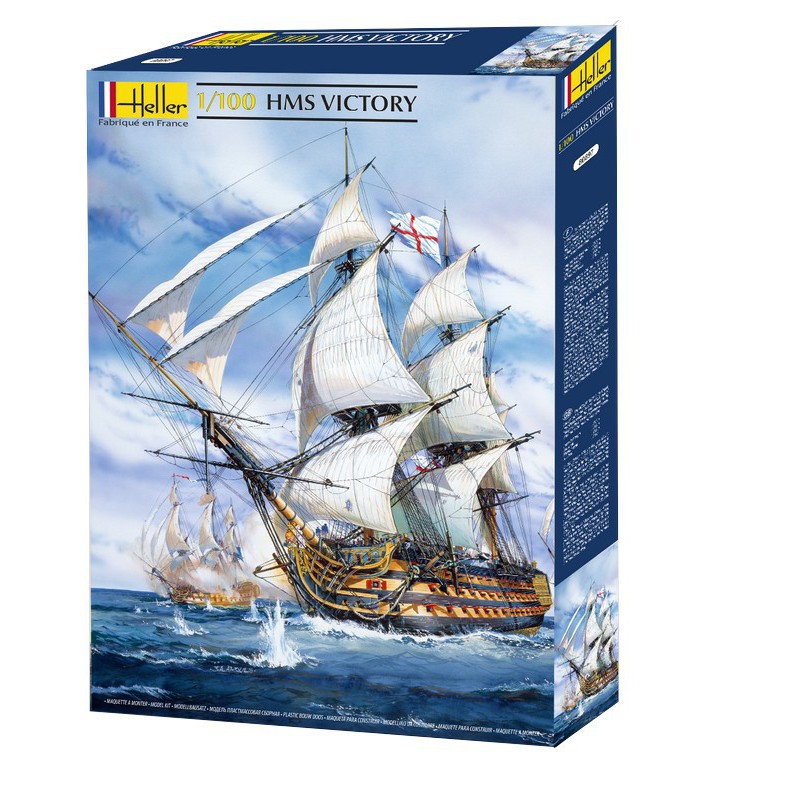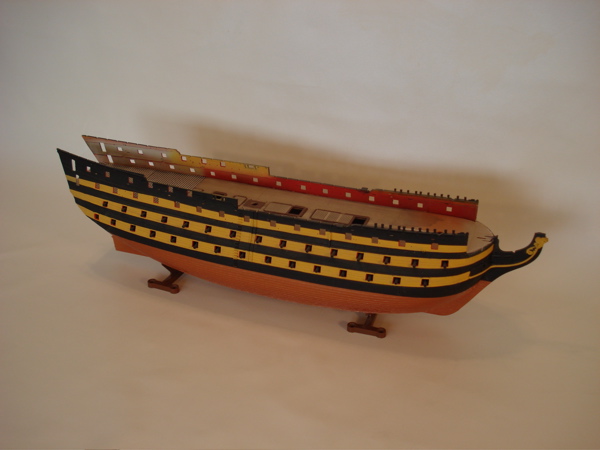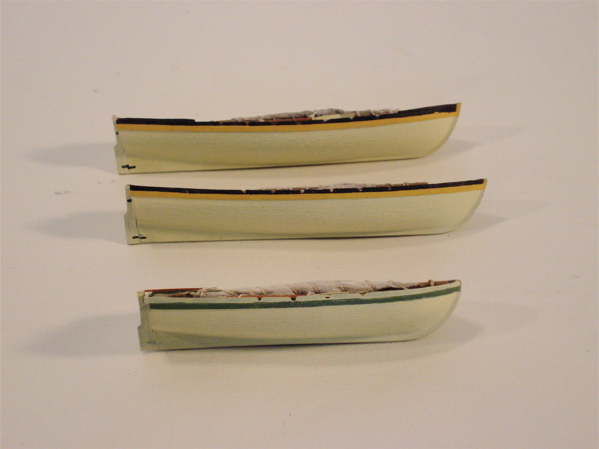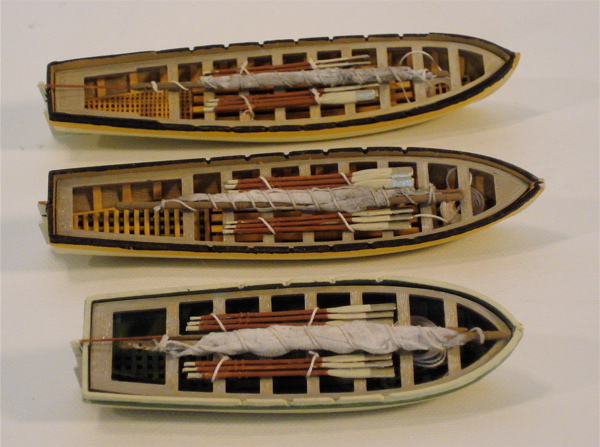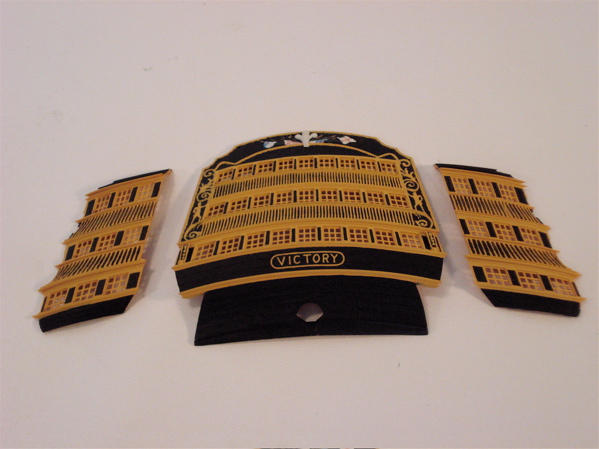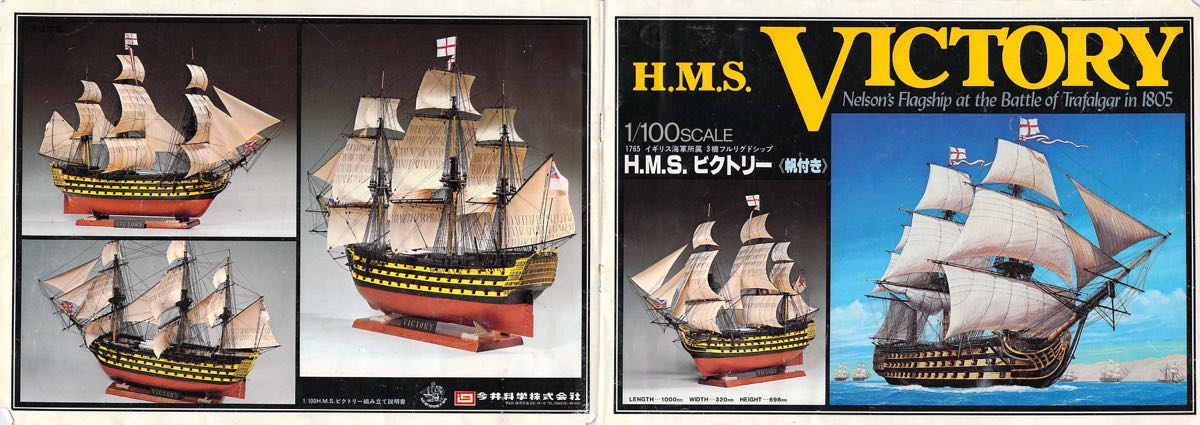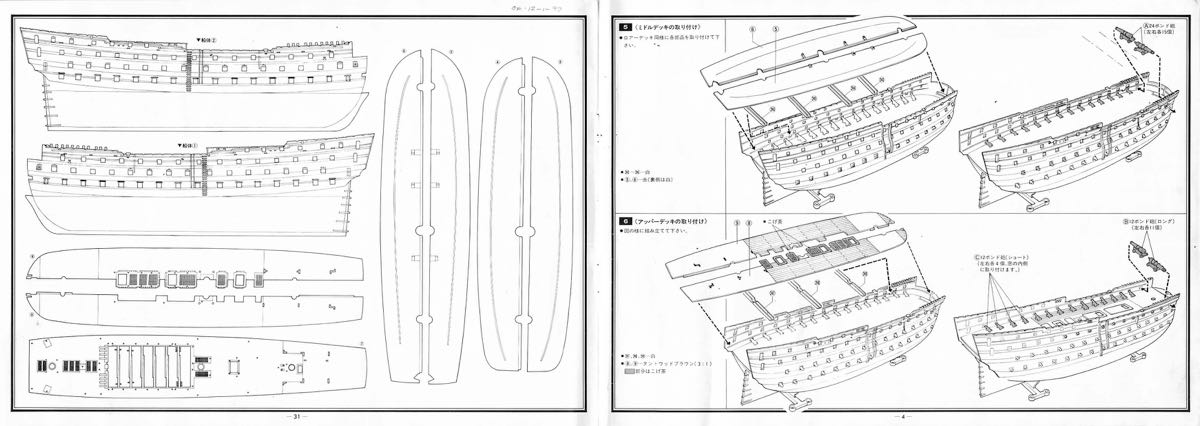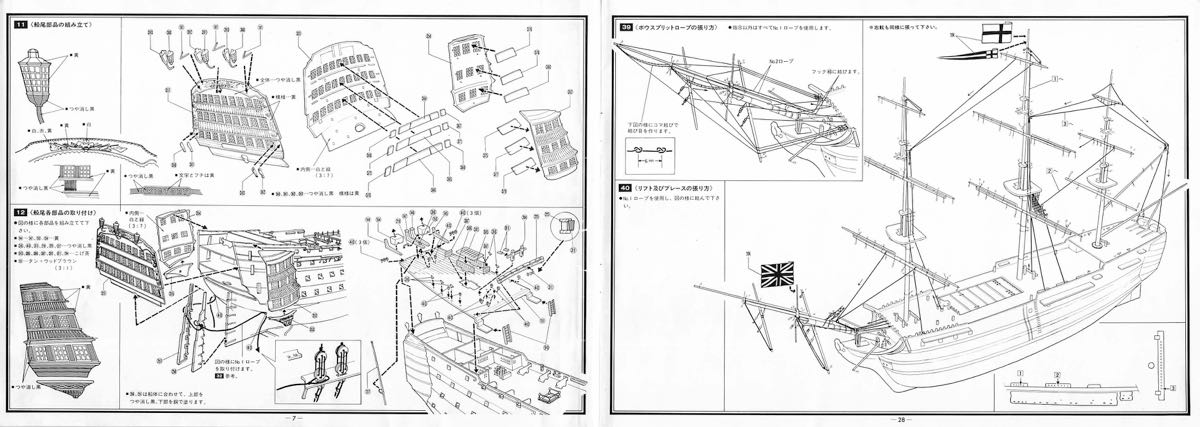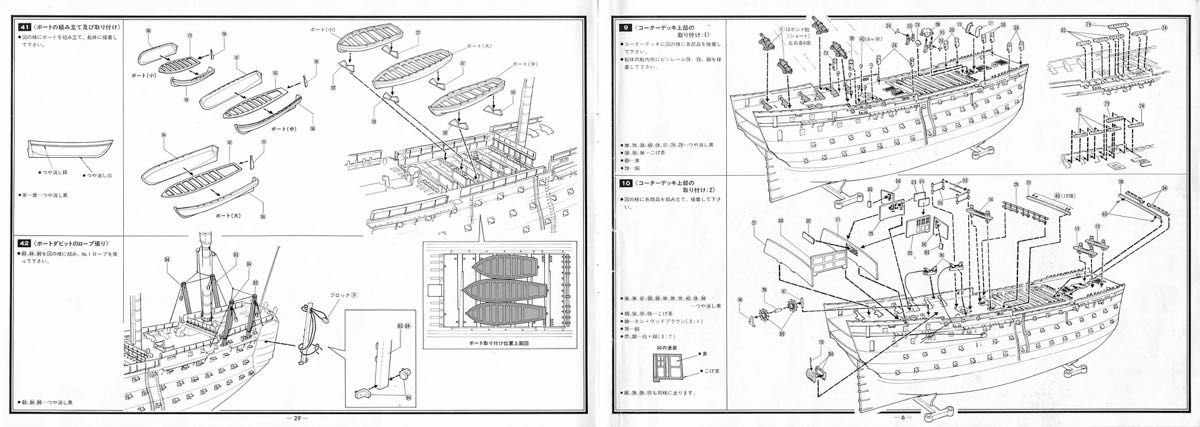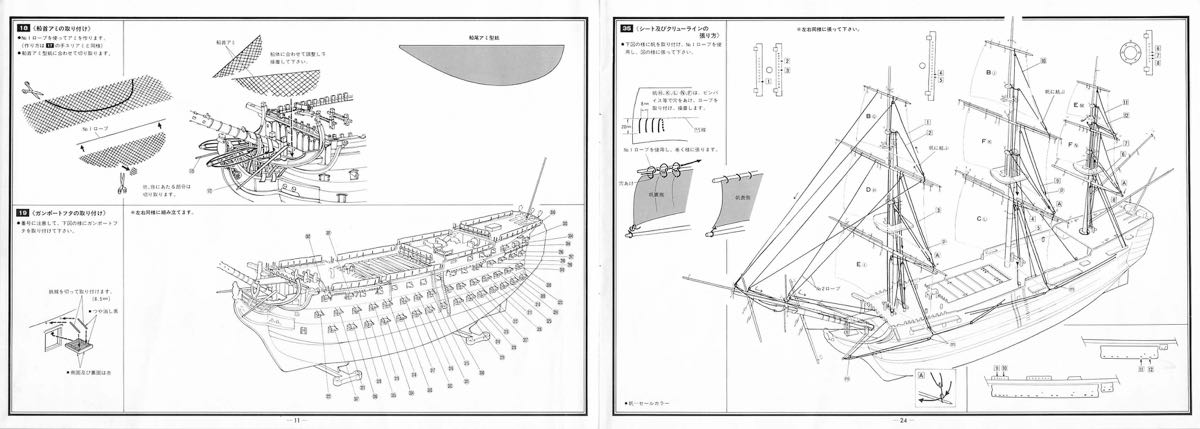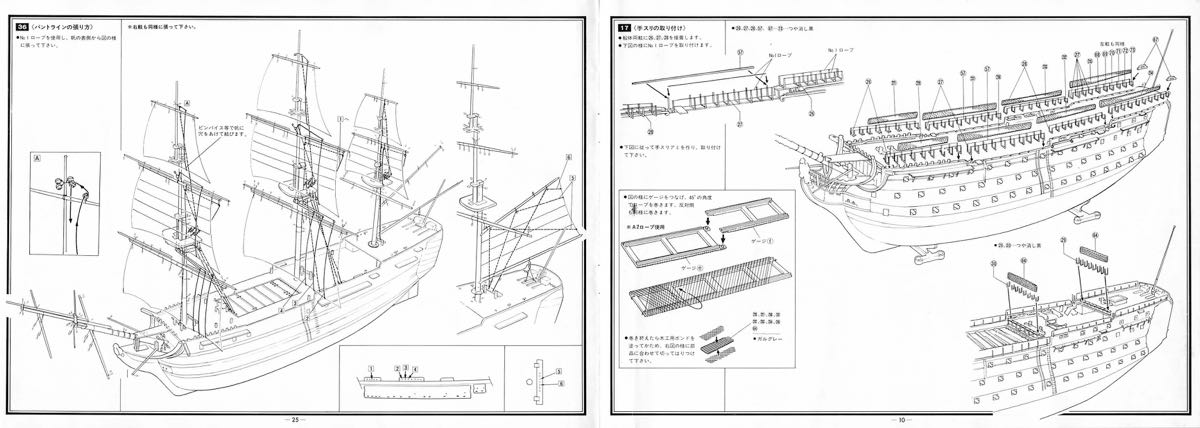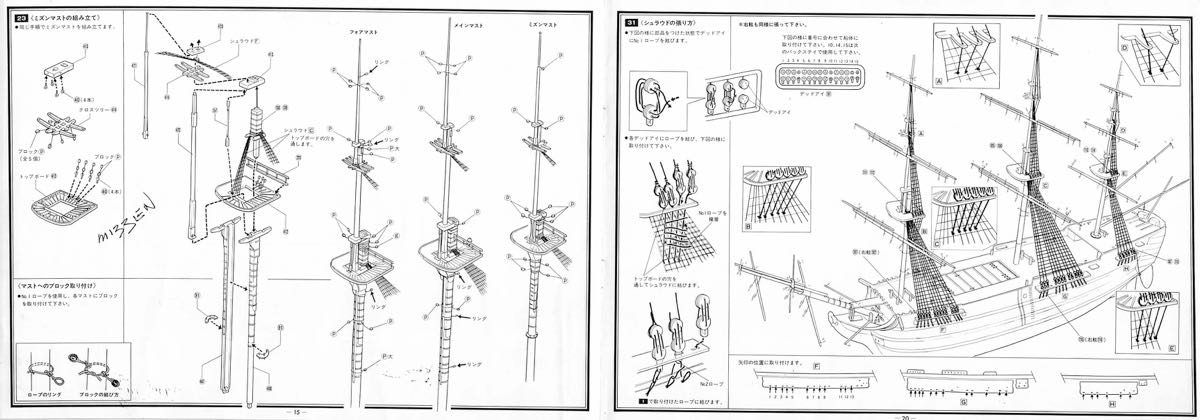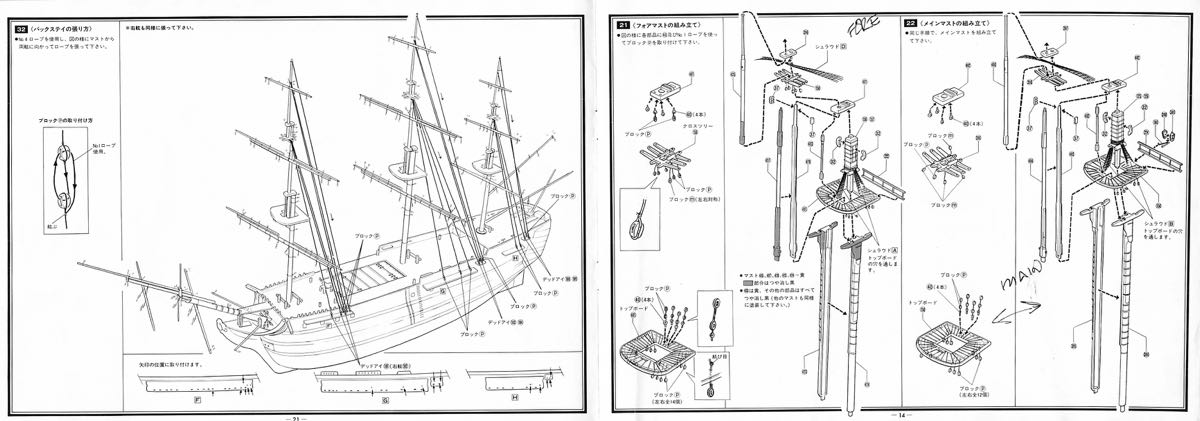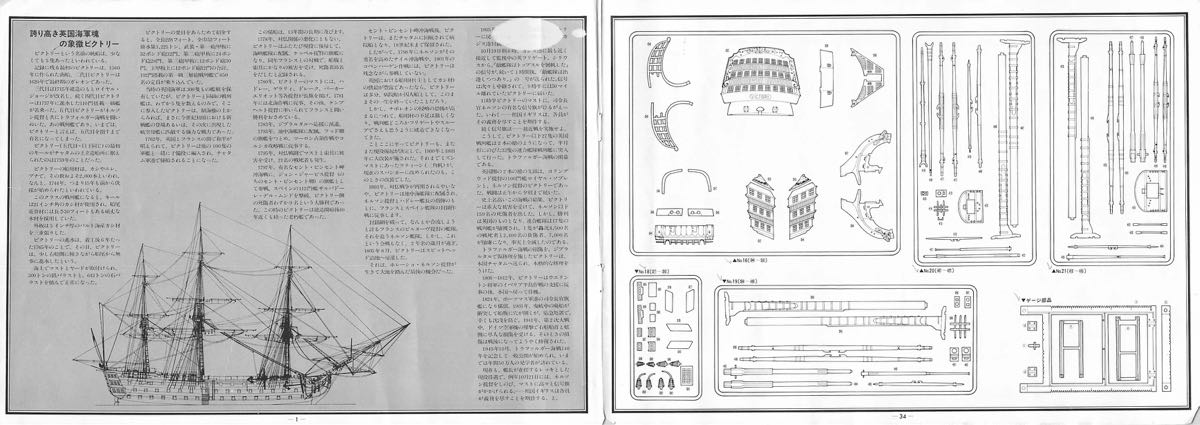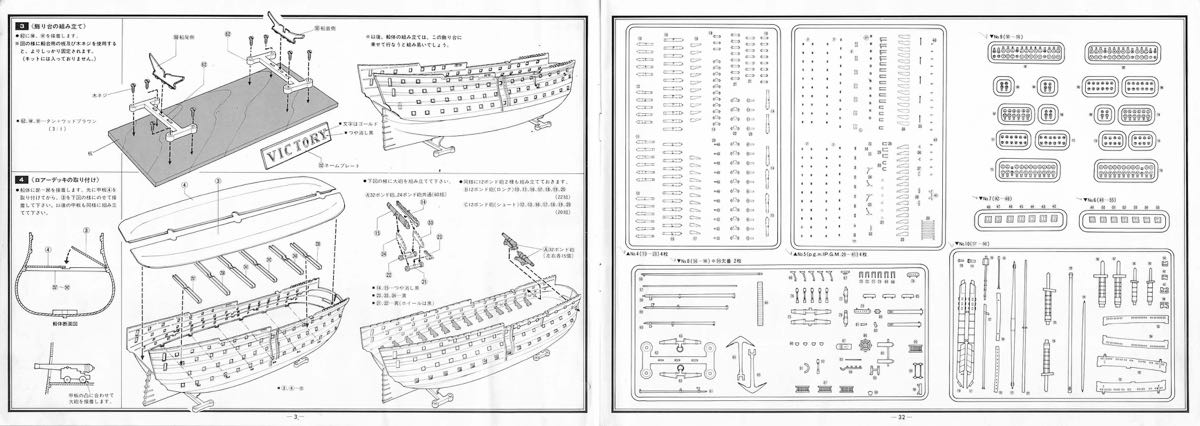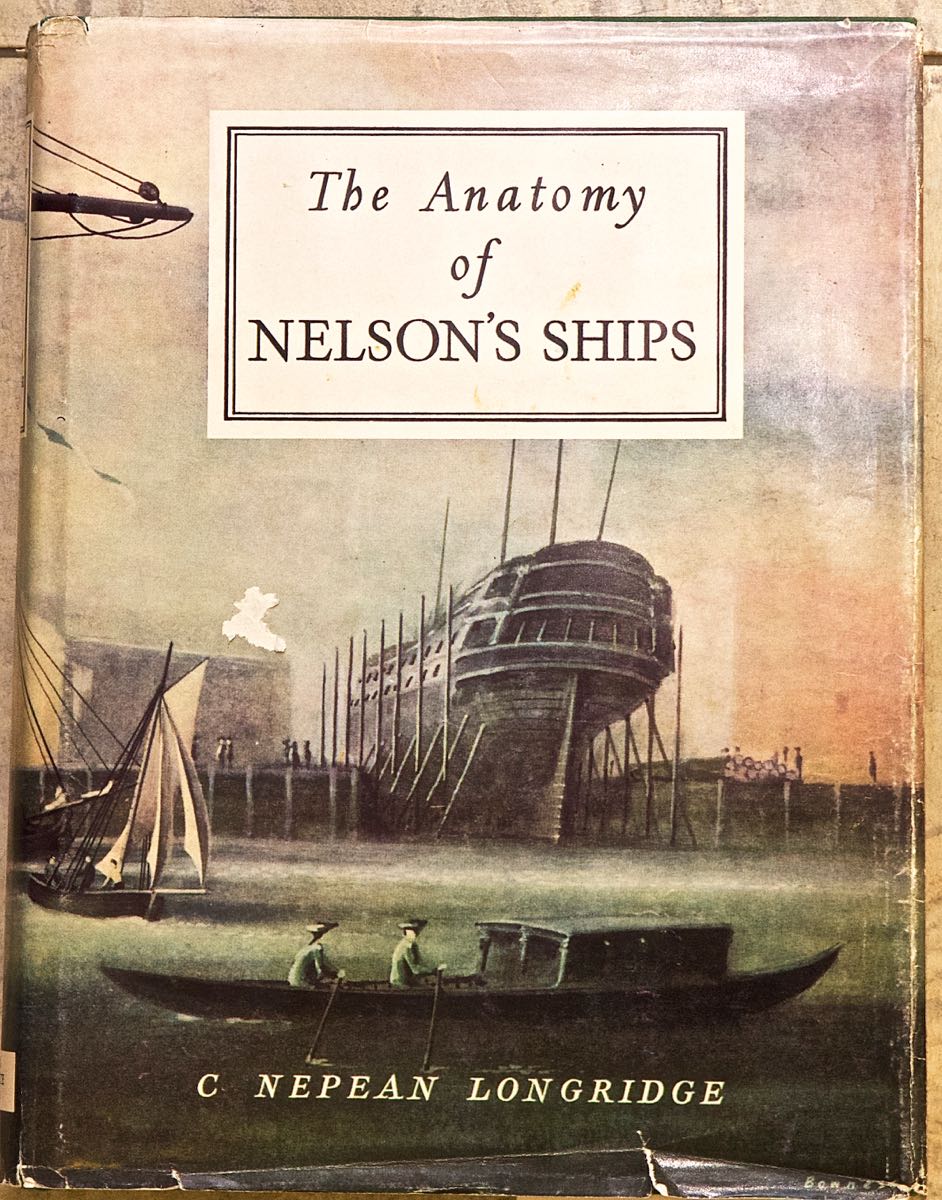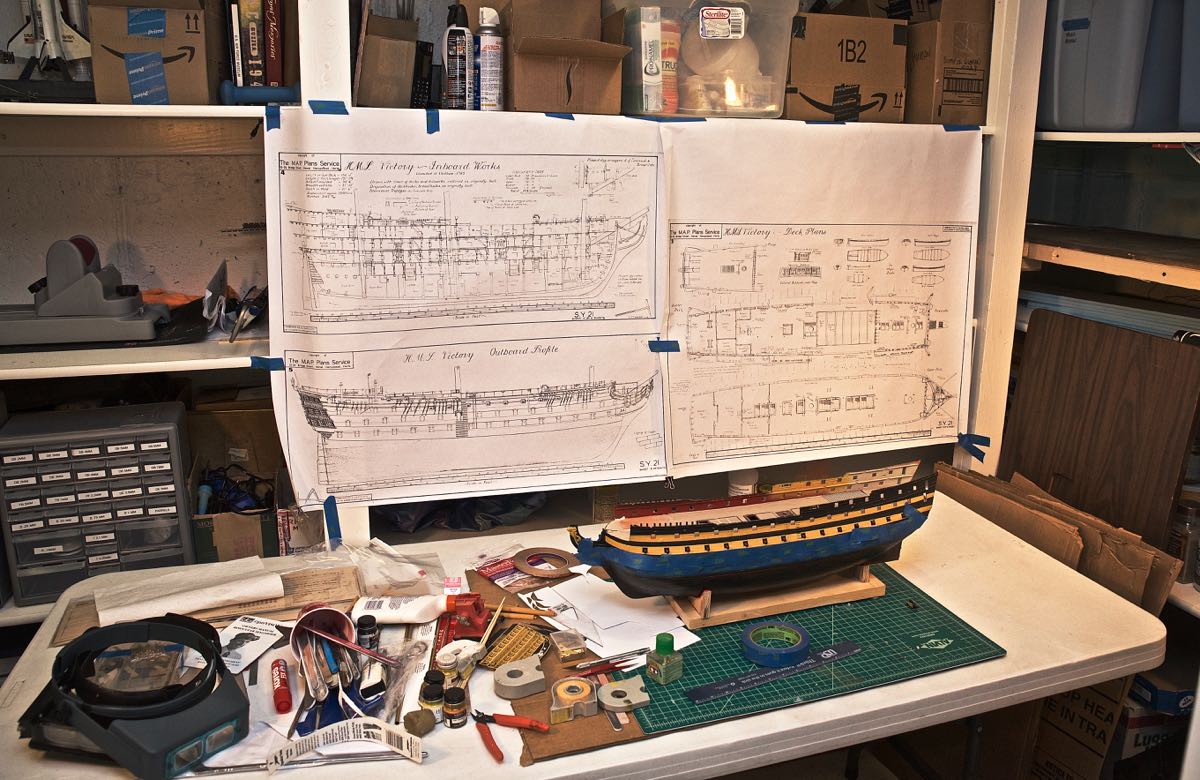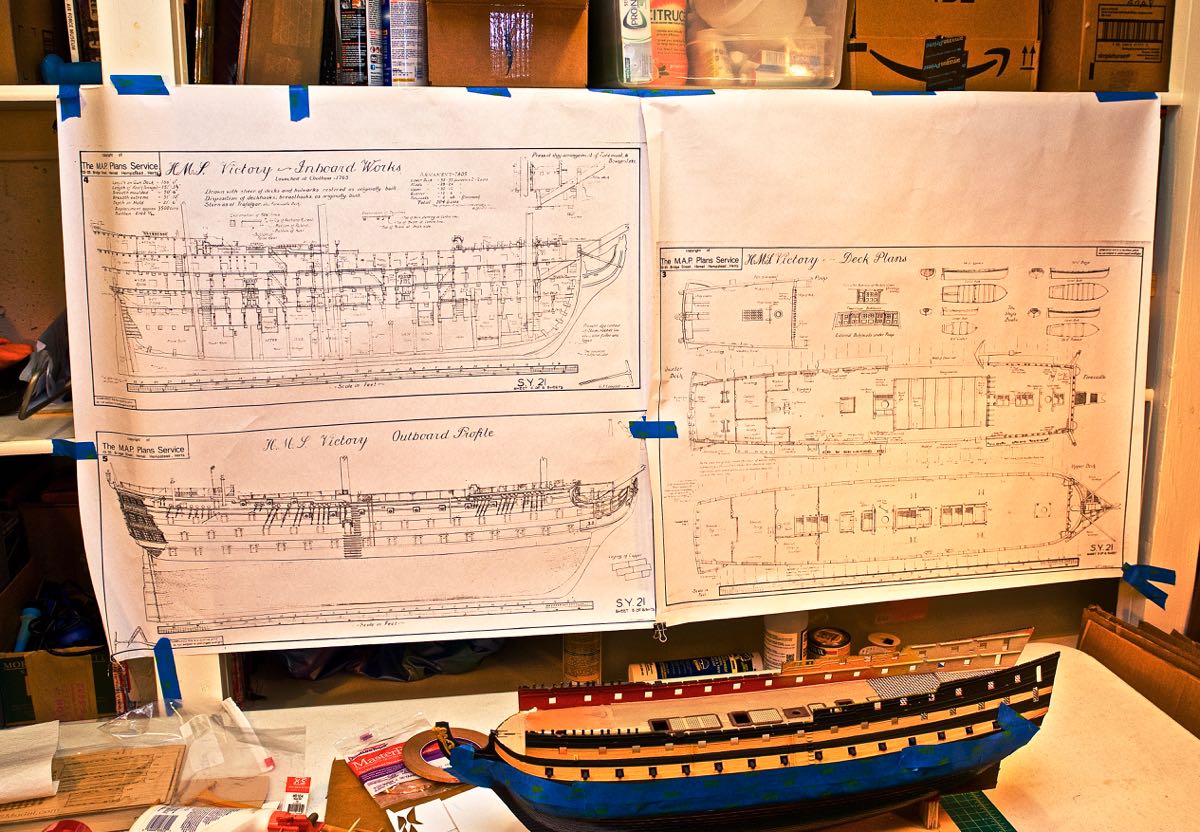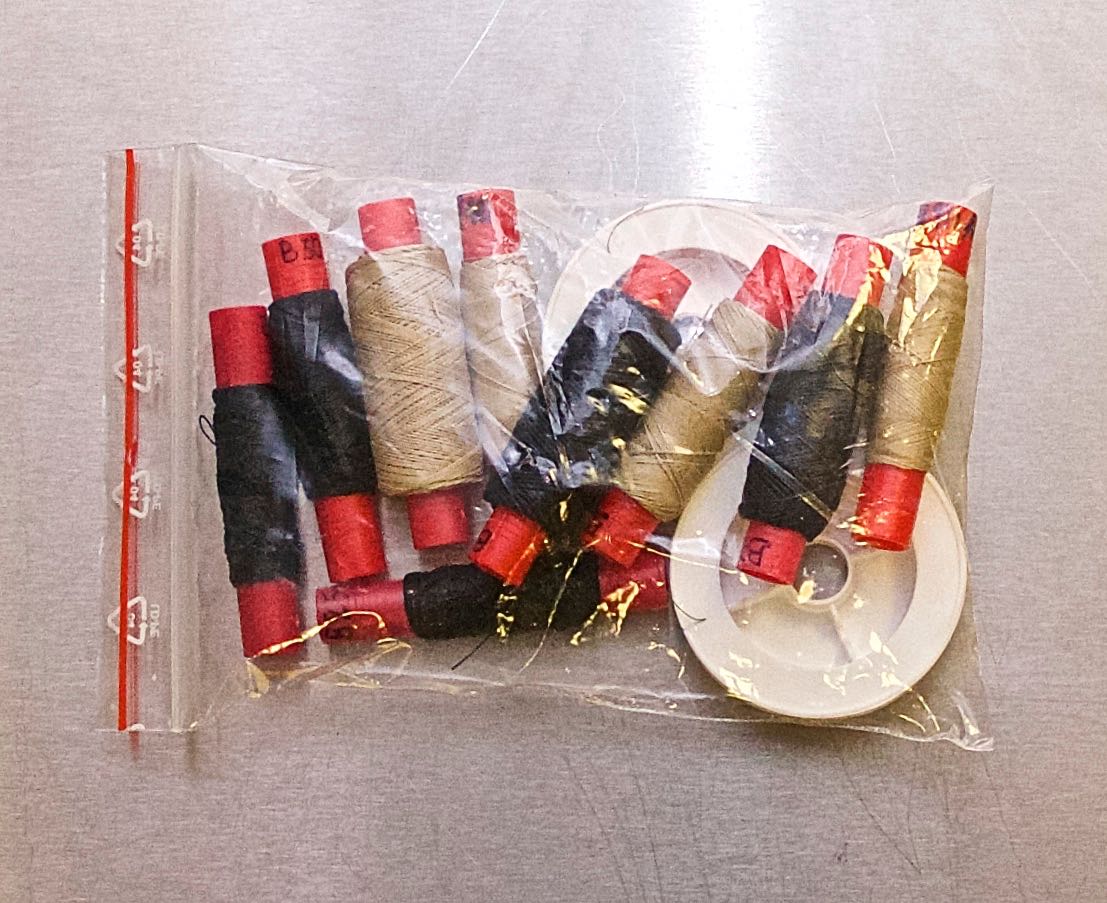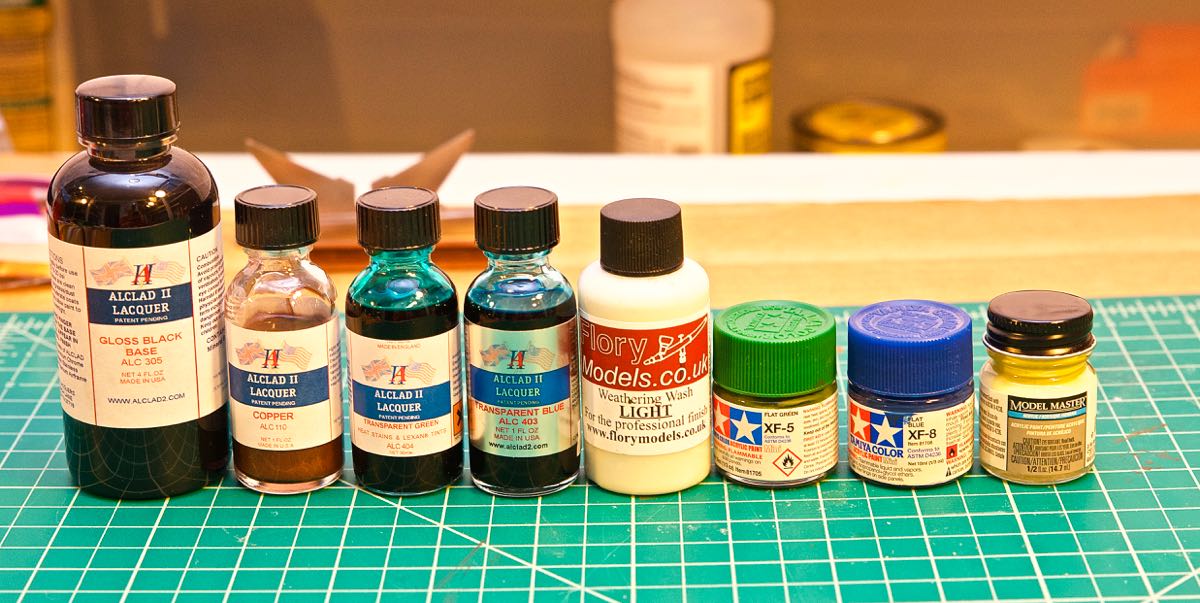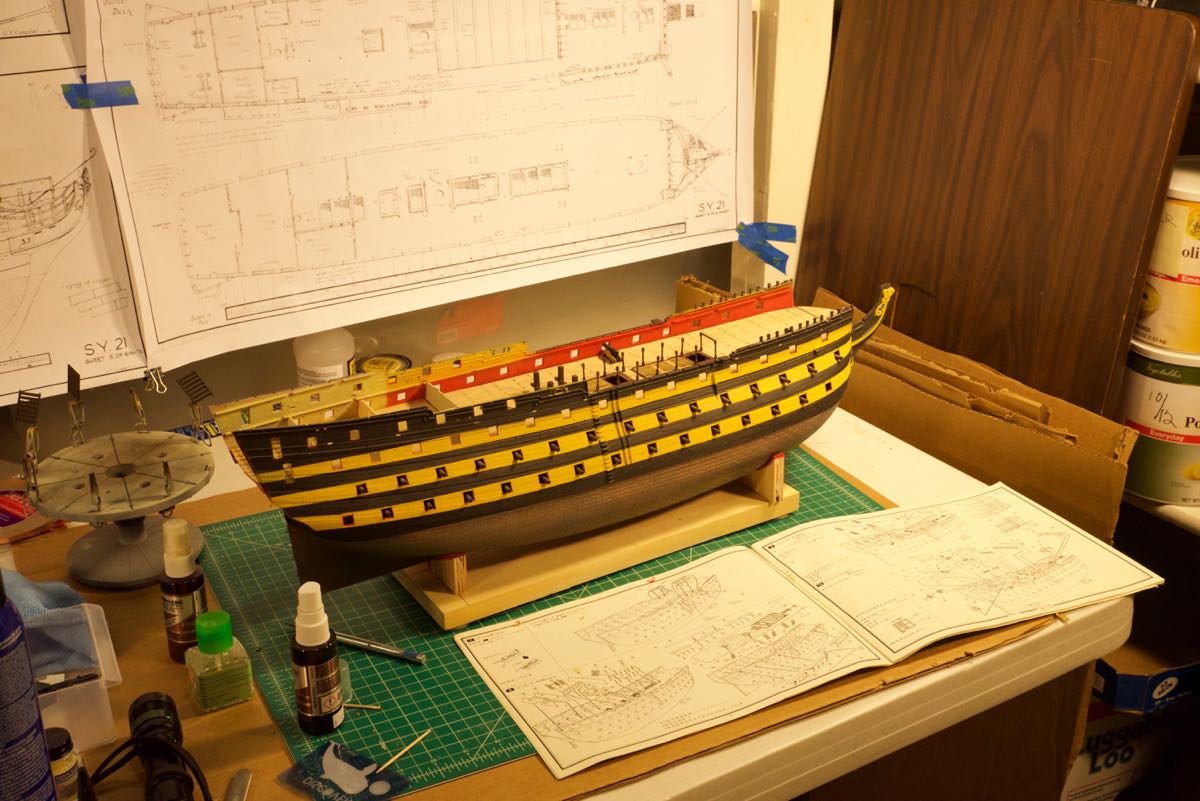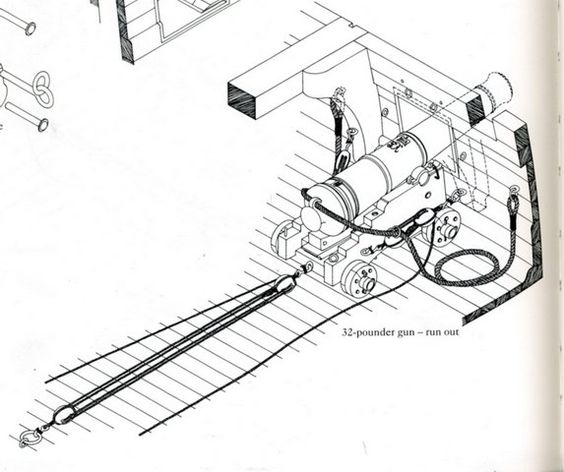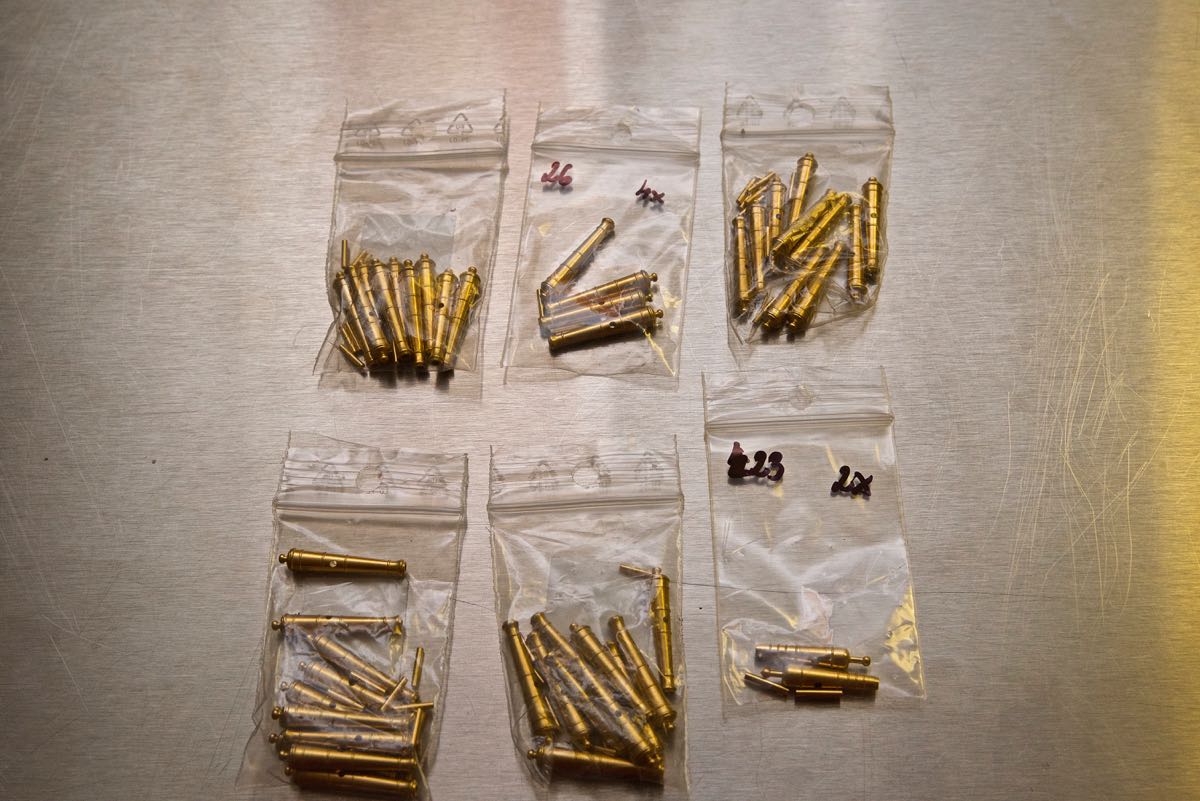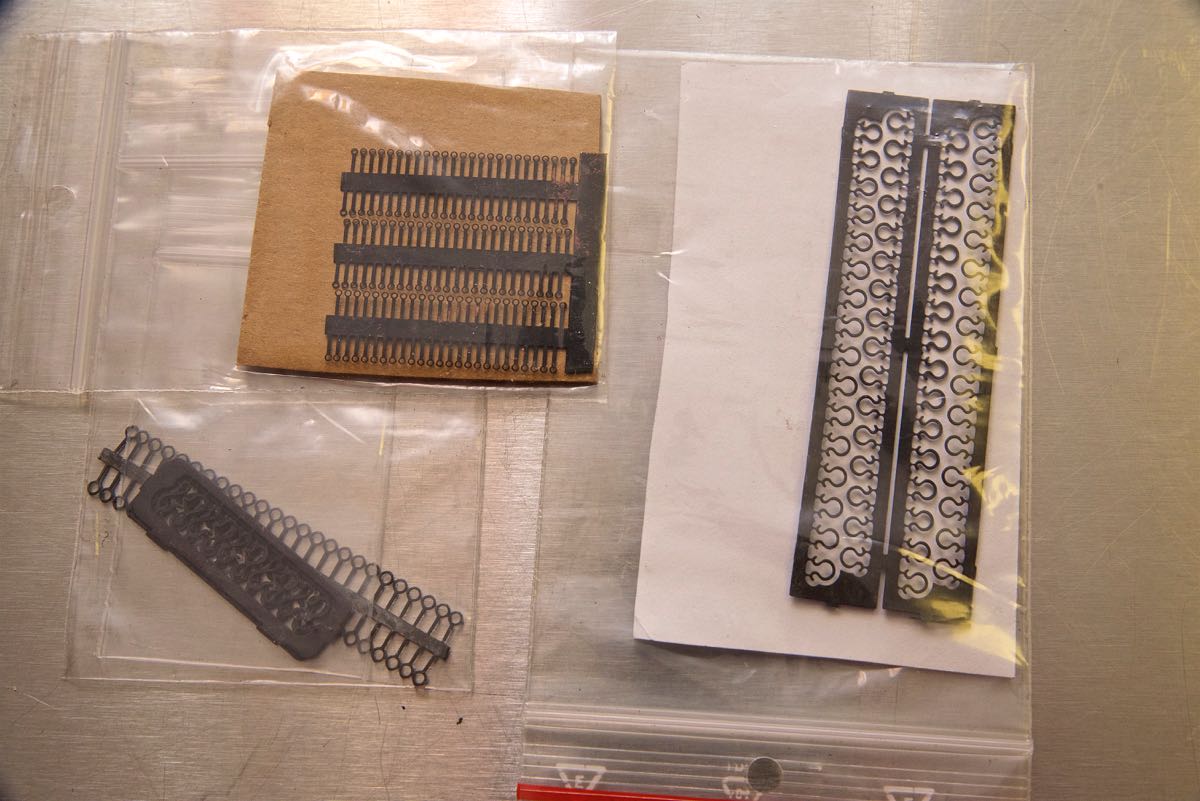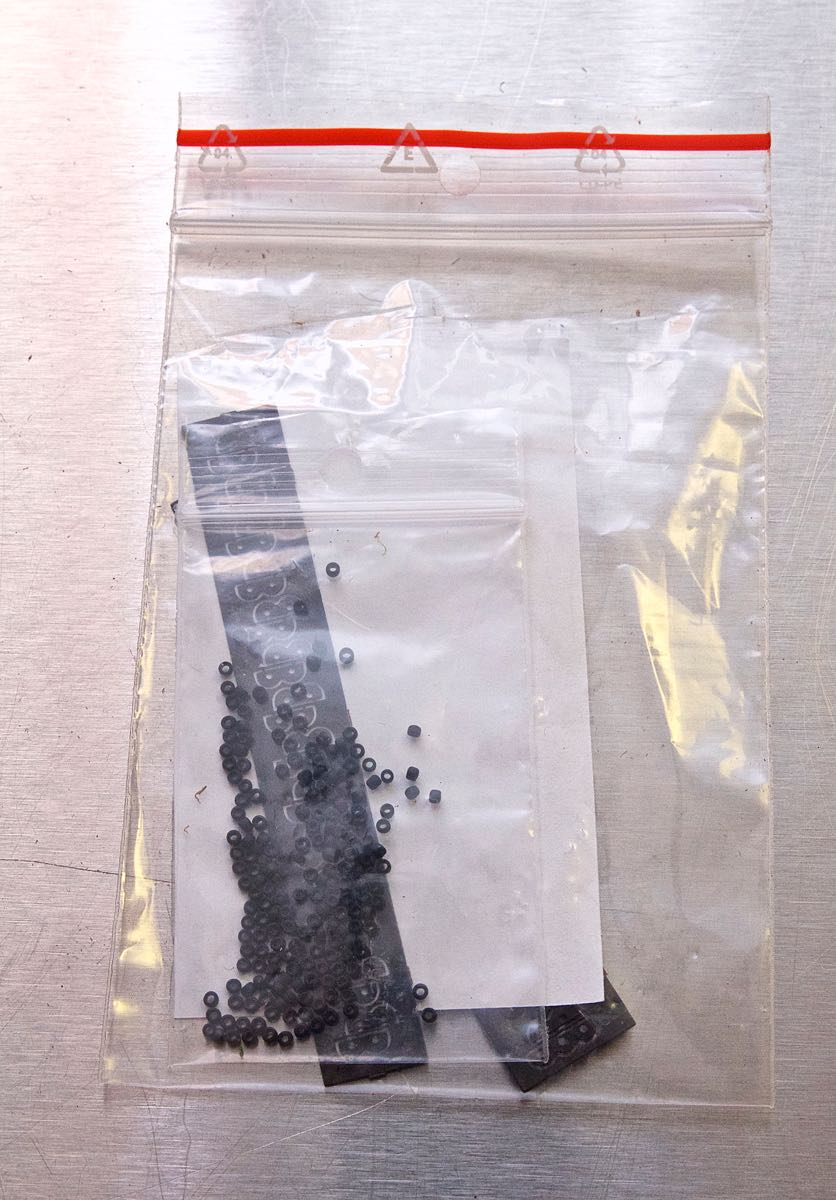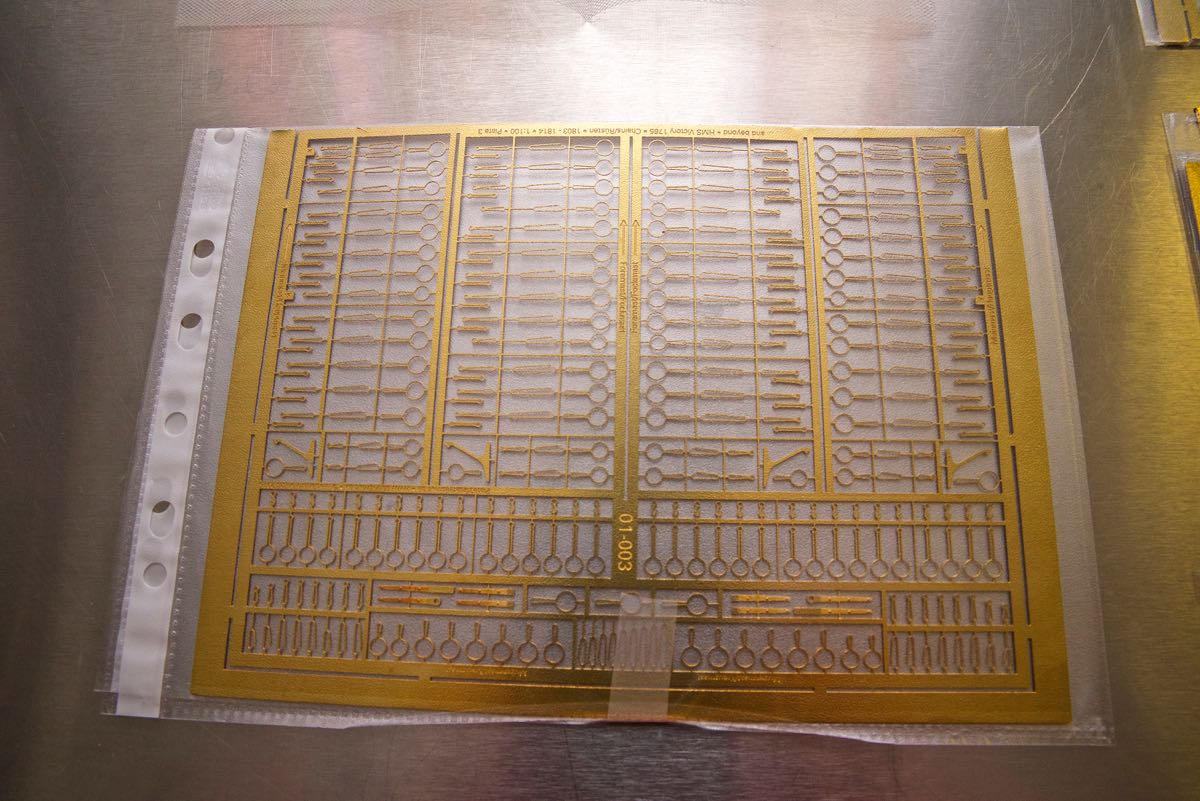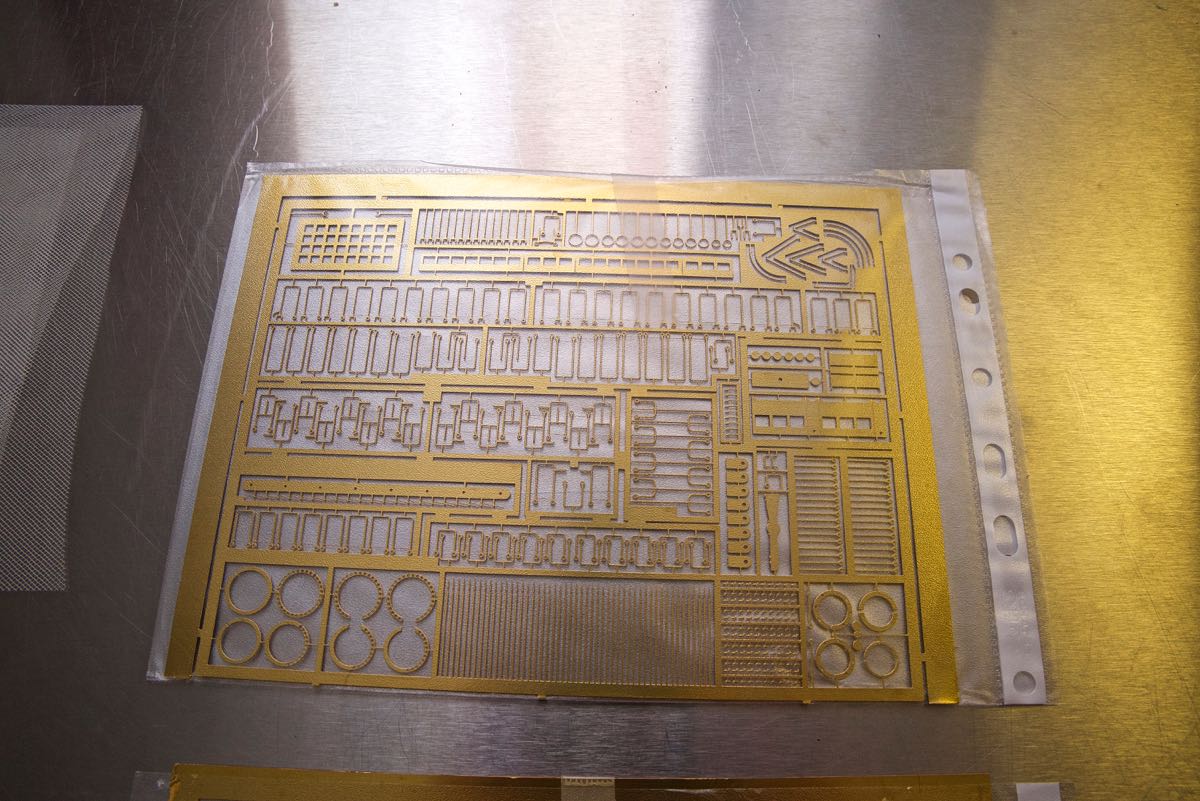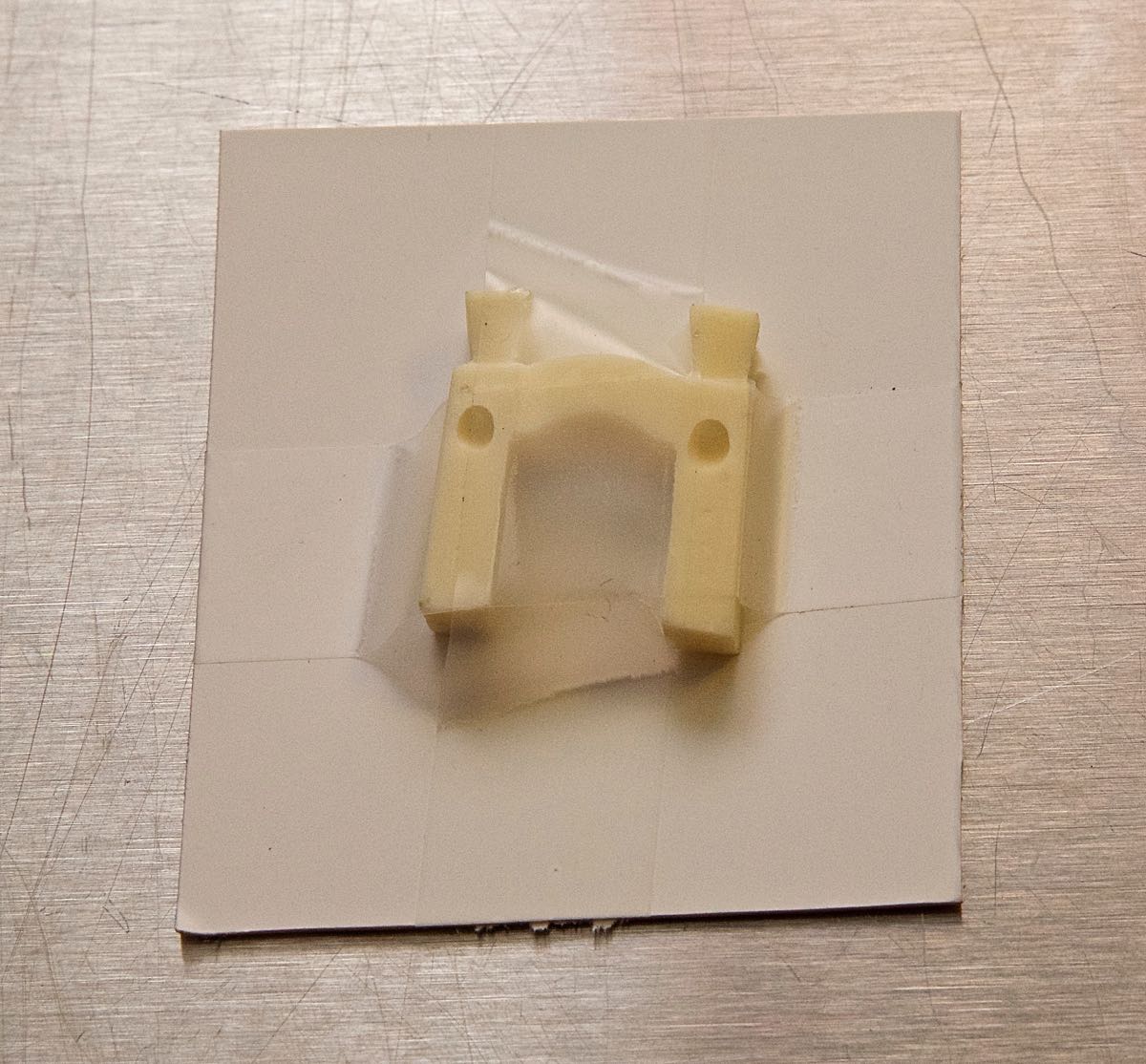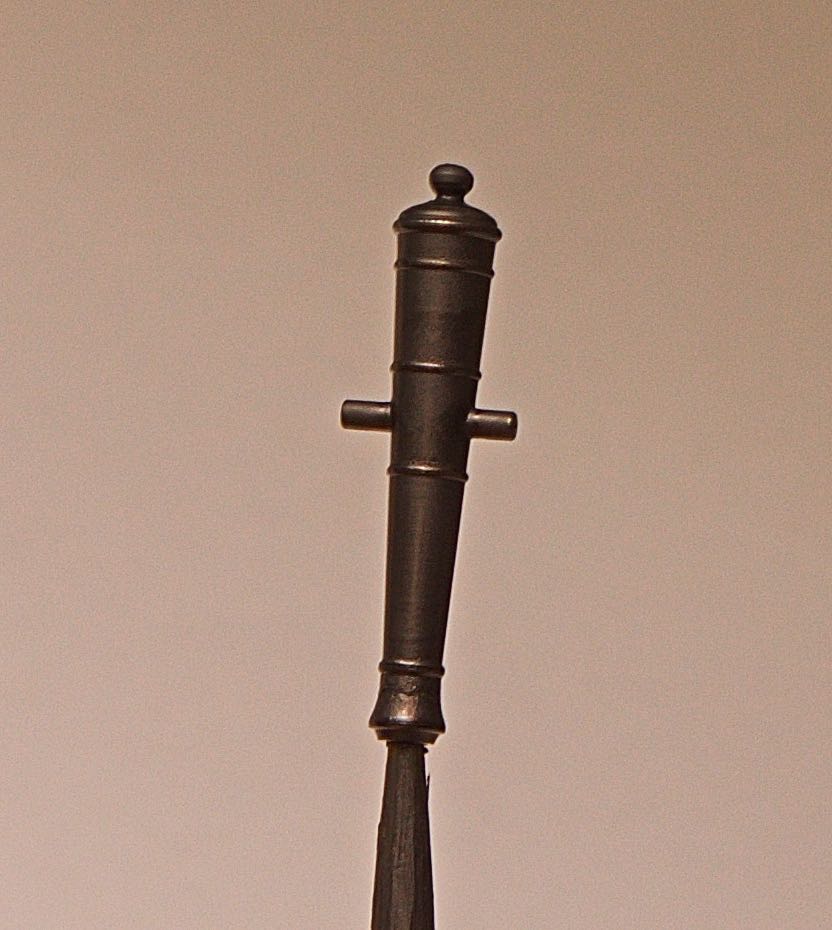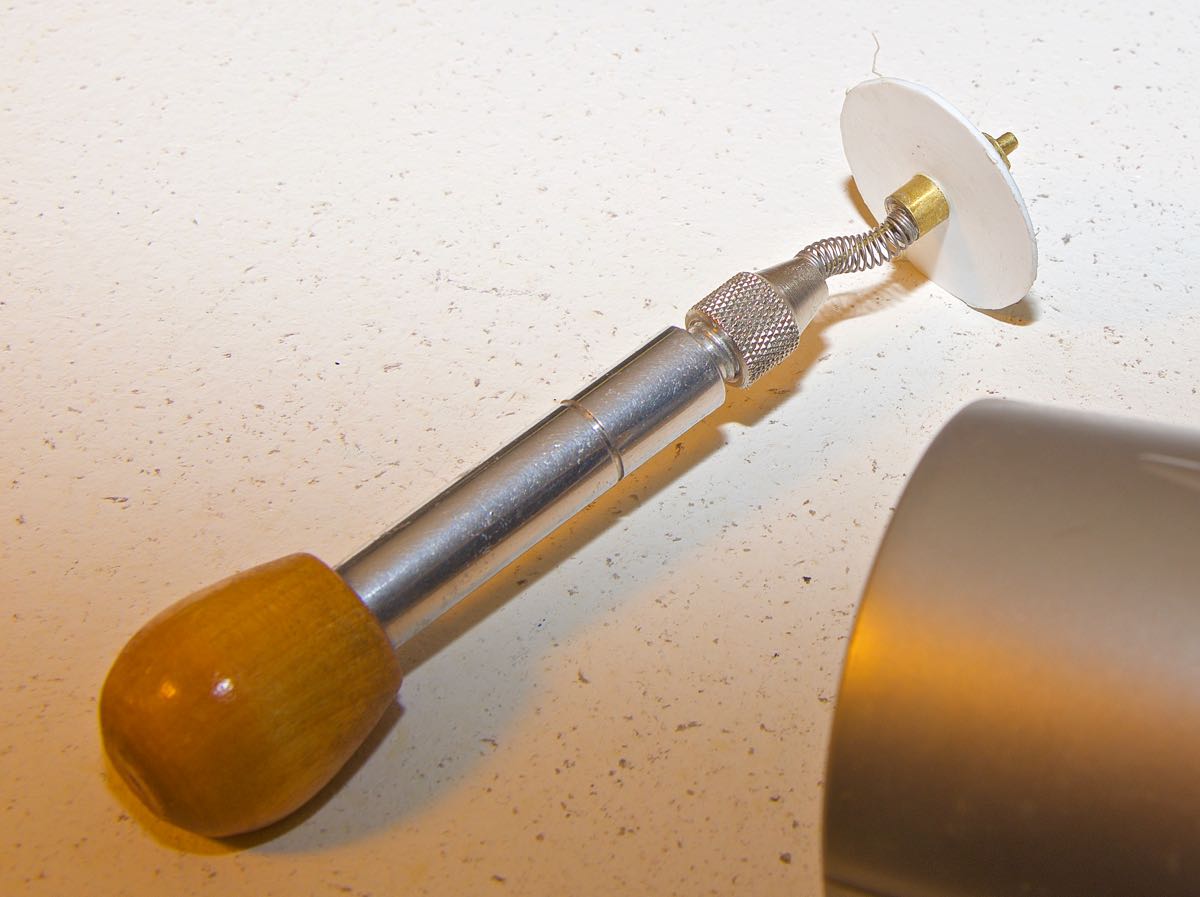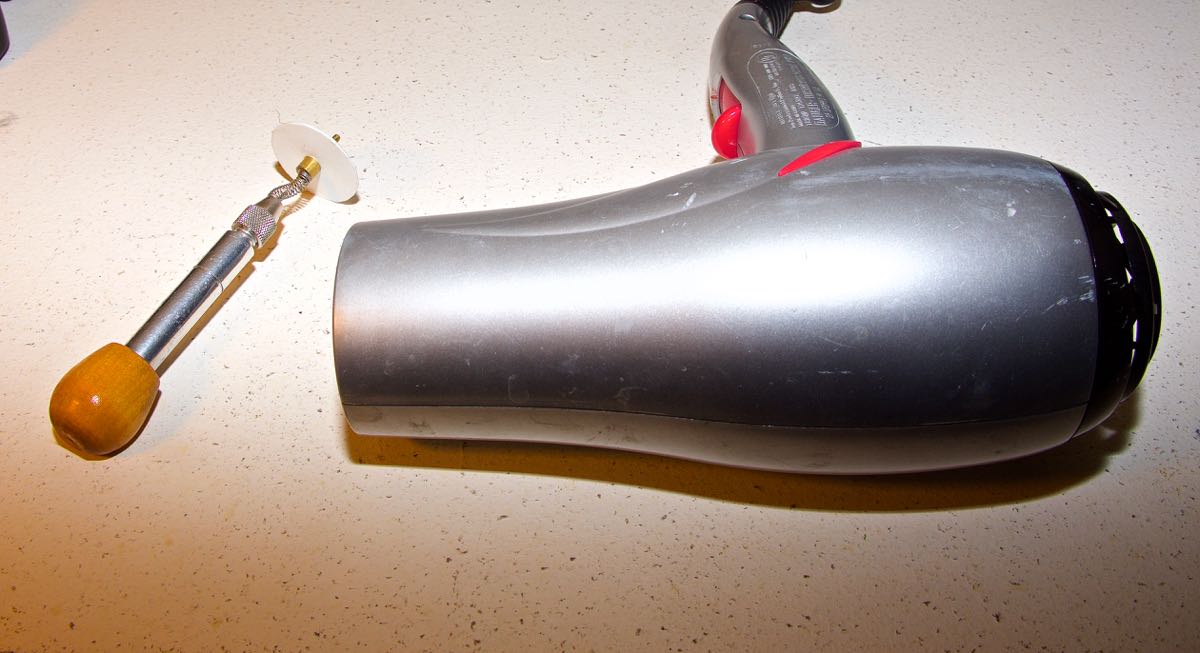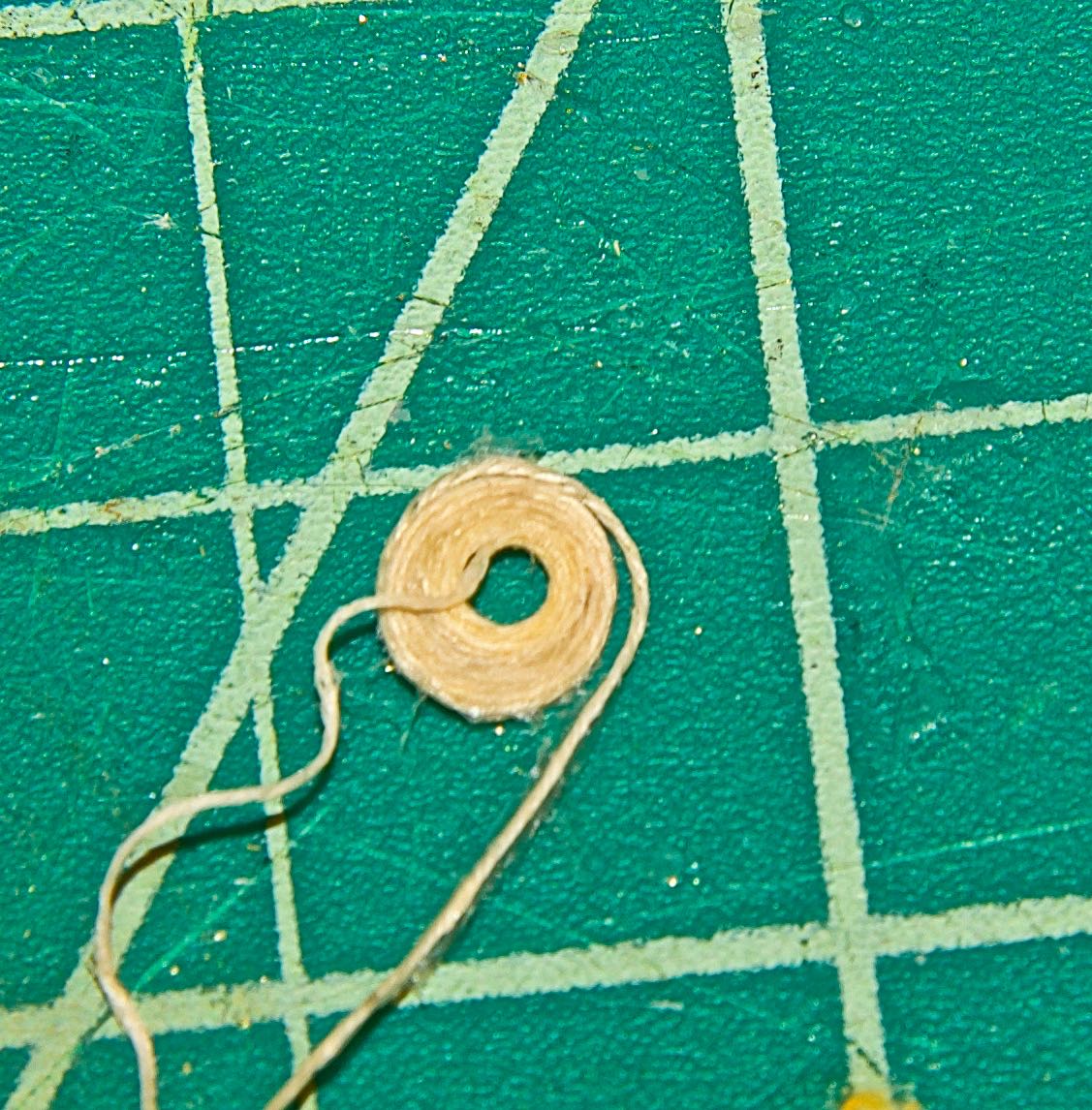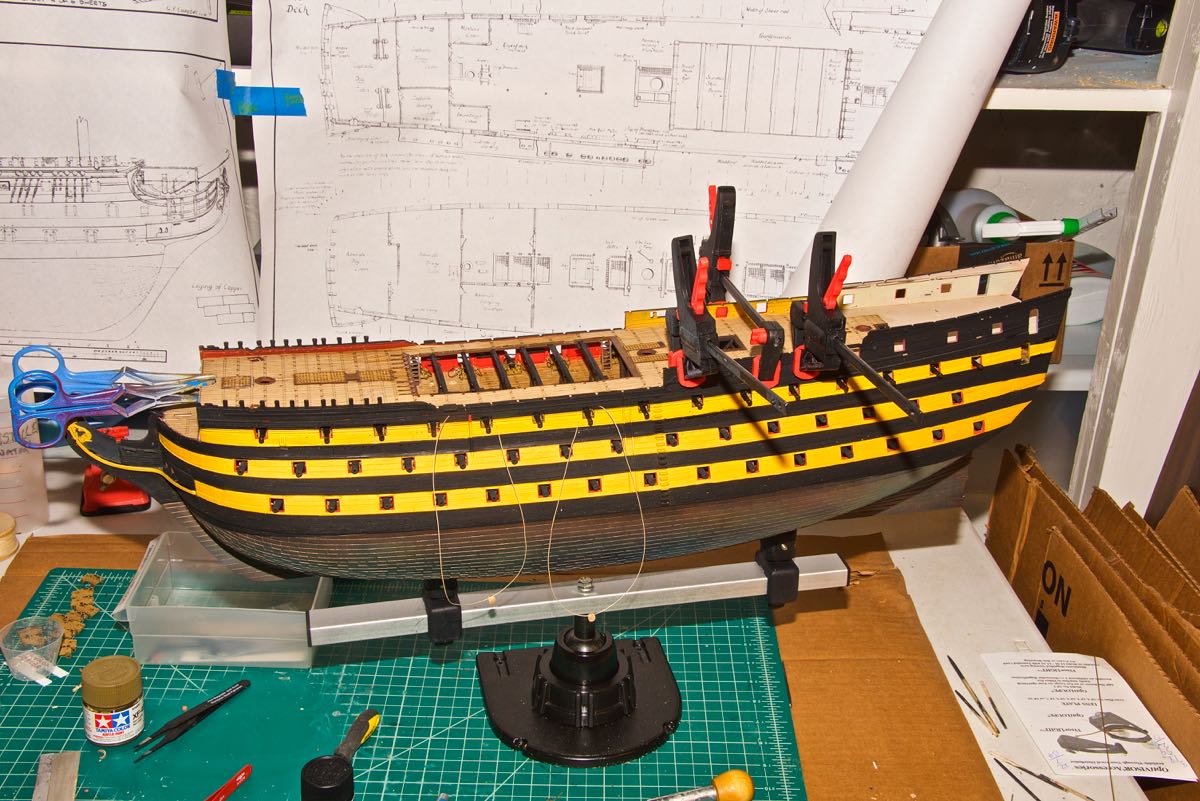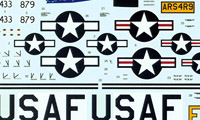10/21/2019 Just a note – In looking back on this build which took several months. My dear wife had passed away 3 months before I decided to finish the Victory. It turns out that the hours and attention to detail all the while in a quiet setting really helped me to deal with her loss. I know that we will be together in the hereafter – but I was missing her terribly and still do. Finishing this was really good therapy for me.
I you would like to see a 10 minute build video – go HERE
I got this model in 1985 from my parents for my birthday – it was produced by Imai, but it’s the same as the one by Heller of France. I got it from Model Expo – they had a half price sale so it only cost $50! I have heard that this version has better quality rigging thread. My chief reference is The Anatomy of Nelson’s Ships by C. Nepian Longridge as well as the HMS Victory website. I have made some progress since then – it’s been slow going (I haven’t worked on this in probably 10 years as of 2009) as you can see from the pics:
10/18/2016 Ok call me crazy – but I'm going to finish this. I have a lot of extra stuff ordered. I'll post pics when I get it.
10/30/2016 Here is the reference material that I'm using in the Victory build.
First are the instructions that come from Heller – to claim that they are adequate would be the overstatement of the year. They are essentially worthless.
Here are the instructions supplied by Imai – the company that produced my kit (which is the same as the Heller kit). These instructions are a vast improvement.
Following are the Imai instructions – feel free to copy for your own personal use:
Next we have "The Anatomy of Nelson's Ships" a masterpiece by C. Nepean Longridge. This book tells the reader exactly how to build a 1/48 scale HMS Victory model. It even has fold out plans and diagrams.
I've had the above plans enlarged to be more usable, as you can see in my "shipyard":
Finally here is "The 100-Gun Ship Victory" by John McKay. This is another must for building this ship.
10/28/2016 Today I got some really fantastic goodies from Radek Beseda – he owns HiSModel in Czechoslovakia. His website is:
www.HiSModel.com
Here are the pics:
First is the thin vineer oak deck:
Here are the fantastic blocks and deadeyes:

Next are the silk flags: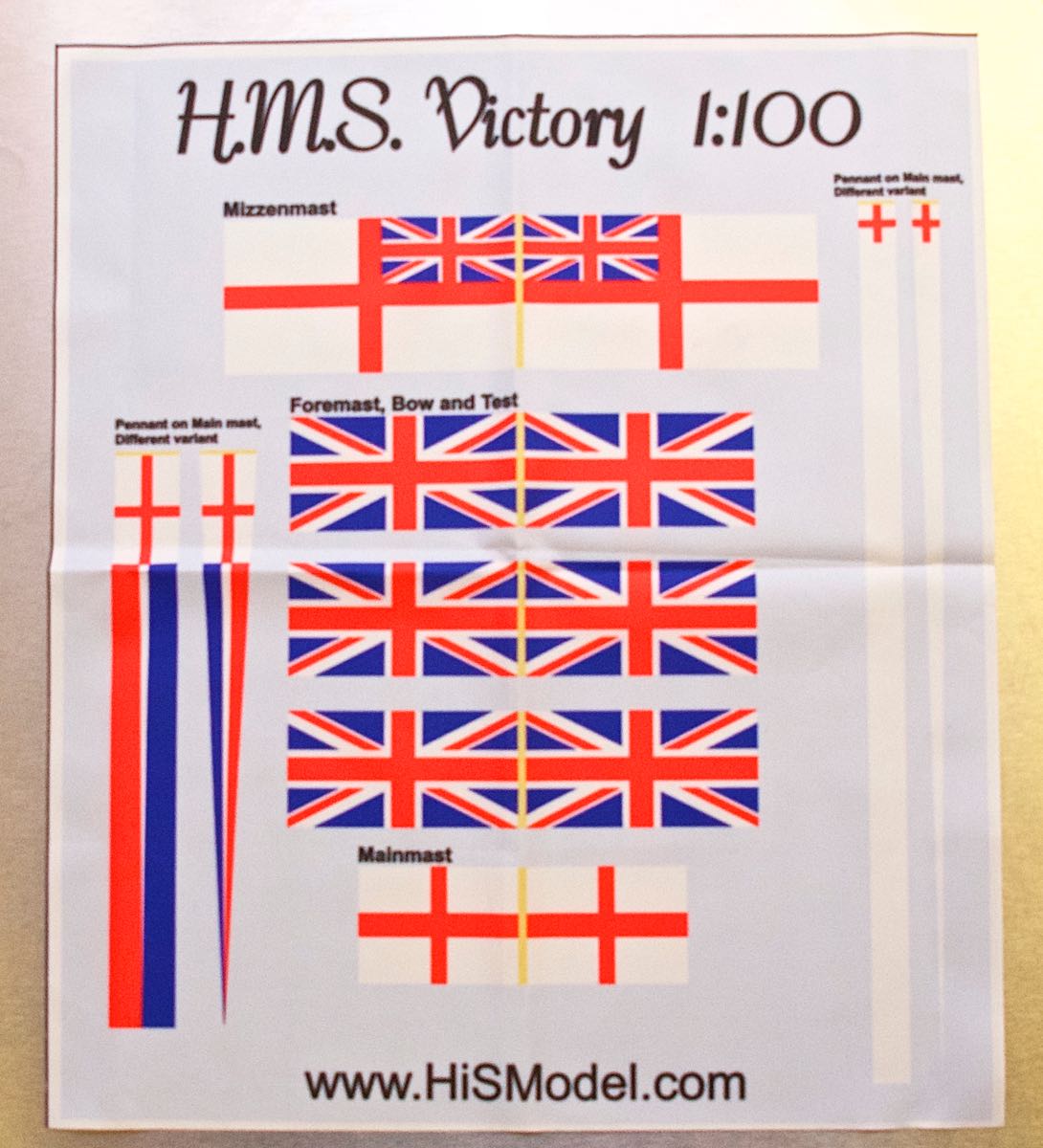
And finally the hand made sails:
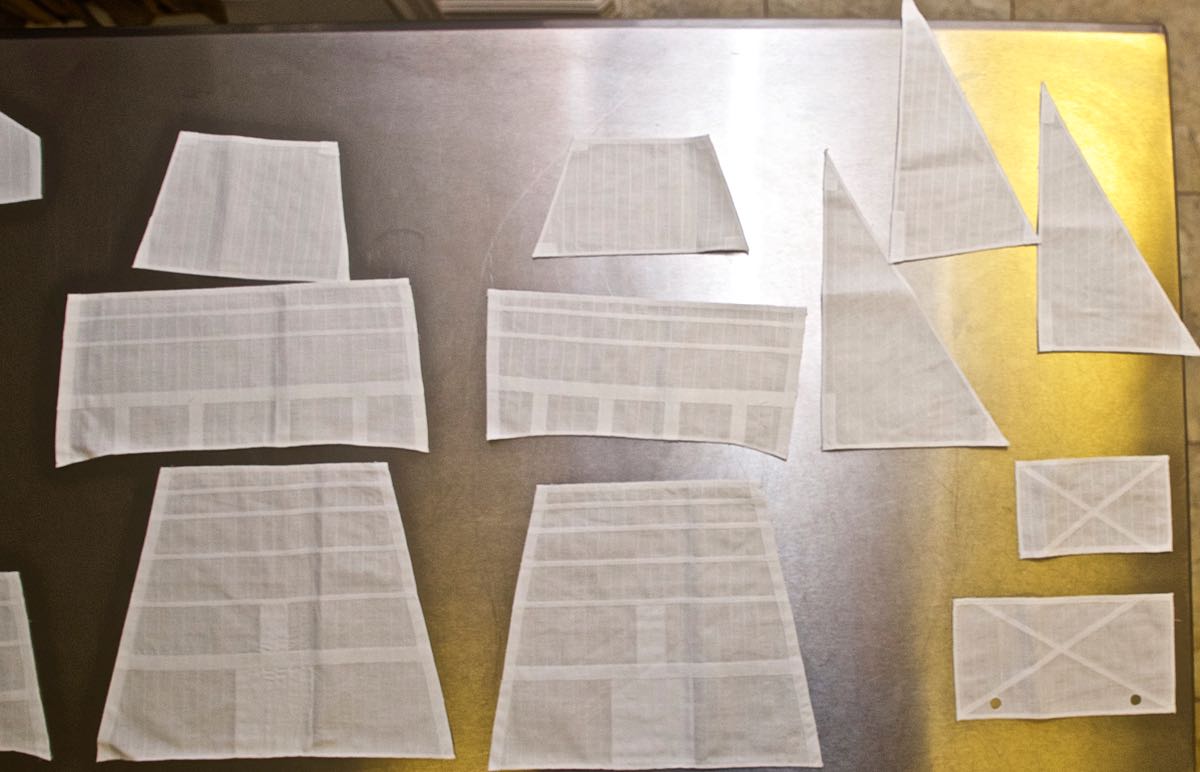
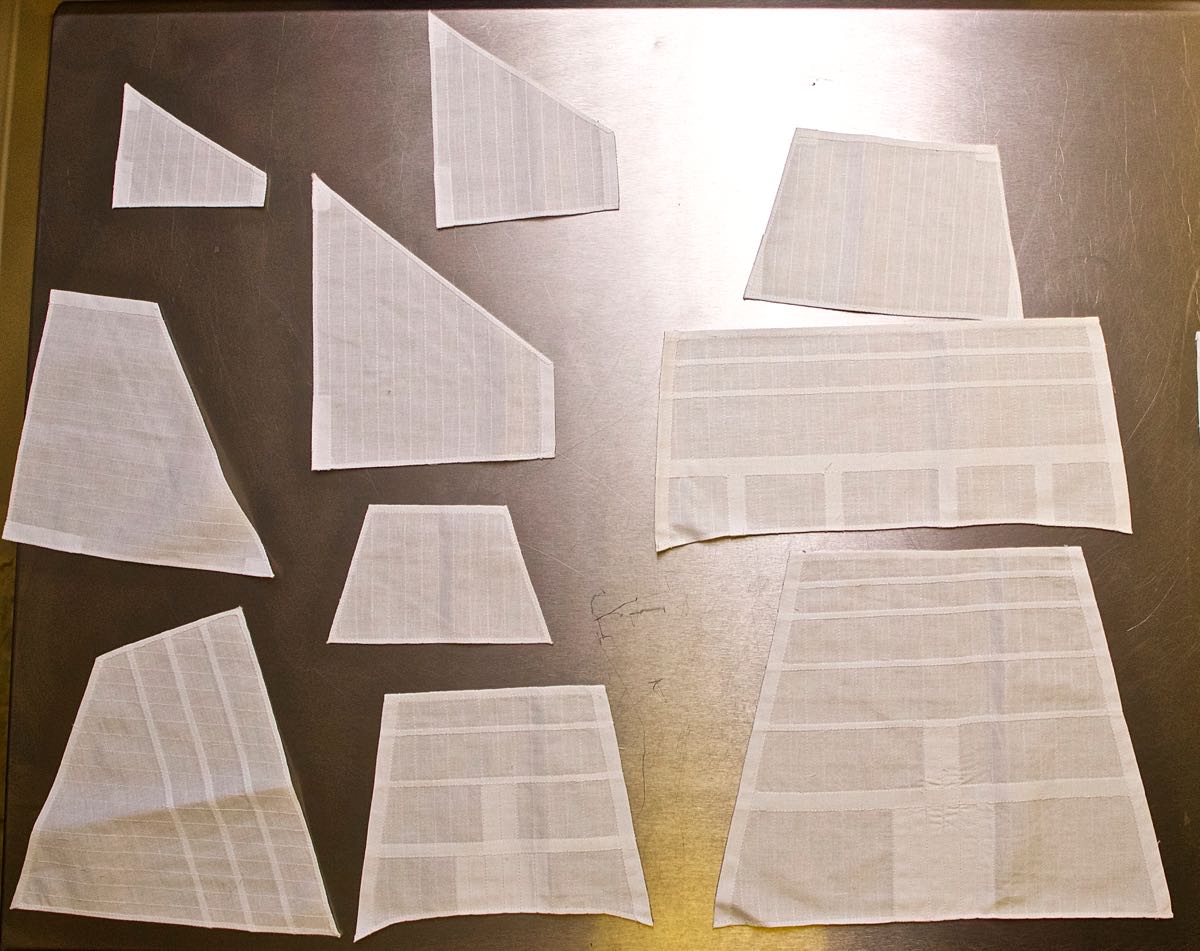
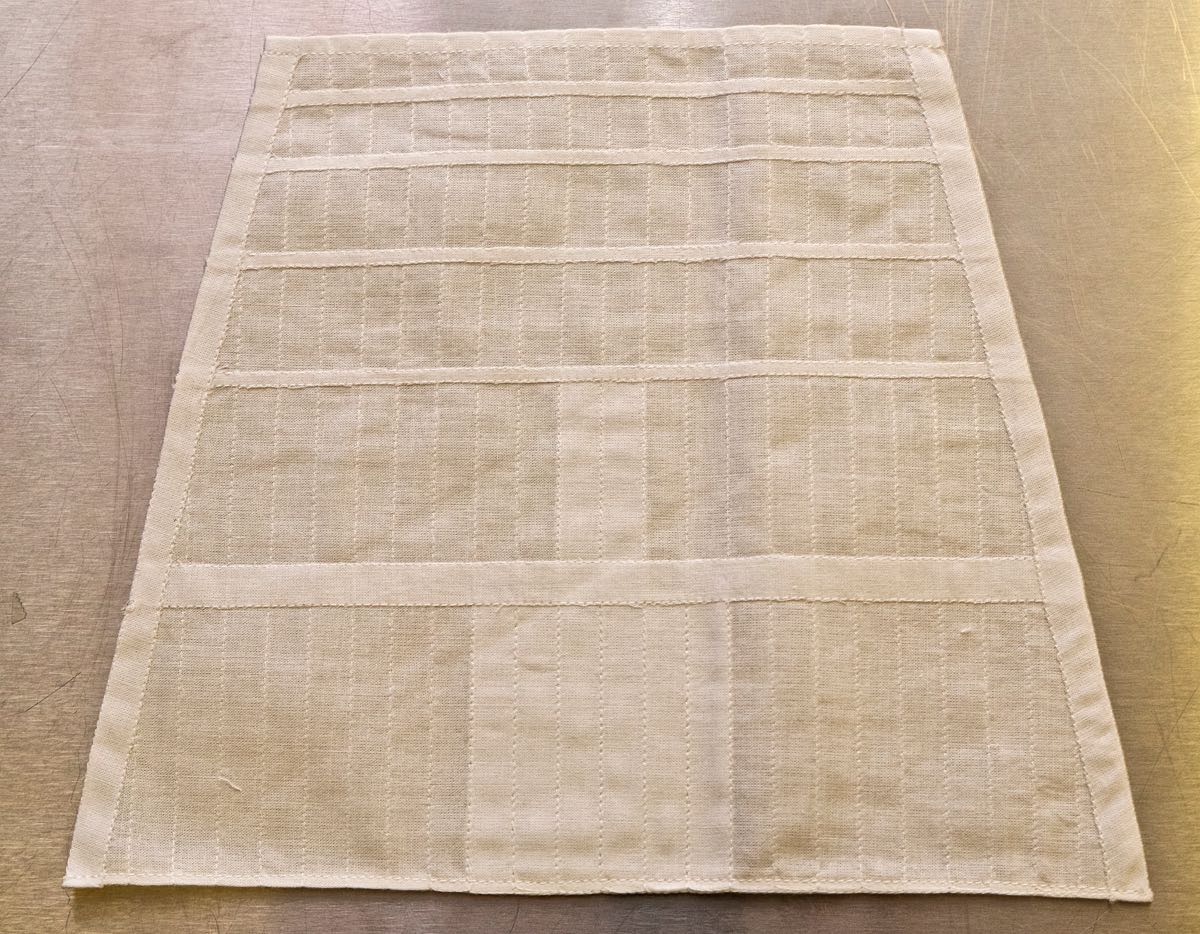
Wow – I can't wait to use this stuff!!
10/30/2016 I didn't like the copper finish on the hull – so I'm redoing it. I've started by respraying it with ModelMaster gloss black enamel. That will be followed by Alclad II in copper, clear blue and clear green. Here is the first step:
11/1/2016 I've finished the hull repaint. Here are the paints I used:
It took a little experimentation to get the effect I want, but I do like what I ended up with. I used very lights coats of the above in the order shown from left to right.
1 Alclad II gloss black base
2 Alcald II copper
3 Alclad II transparent green
4 Alclad II transparent blue
5 Flory Models weathering wash – light
6 Tamiya XF-5 flat green
7 Tamiya XF-8 flat blue
8 Model Master Acryl aged flat white
All of these added very subtle effects. Here is the final result:
11/2/2016 I've started attaching the veneer decking and deck furnature on the second gun deck. I used Loctite spray adheasive to hold the deck down. Here are some pics:
This is before I started….
Here are some shots at this stage …
Next I will be installing the cannon on this deck. There are several that will be visible when the ship is finished, so they will have to be full rigged with block and tackle. I have extra blocks and eyehooks on order for this. This will be quite involved, so it will be interesting to see how well I can replicate this. Here is the cannon rigging diagram:
11/9/2016 A few days ago I got some more goodies.
Here are some things from HiSModel:
6 mm belaying pins – 100
blocks for guns
cnc brass gun barrels
eyelets and hooks
wood channels
2 and 3 piece parrals
https://www.dafinismus.de/index_en.html
Or you can just click HERE.
Photo etch (channel irons, decks fittings, eyebolts & hooks, and cast knighthead)
11/10/2016 The upper deck gun carriages have been assembled and painted. I'll probably paint the carriage wheels a slightly different color. I still have to attach the gun tackle ring bolts.
11/11/2016 I'm working on the cannon rigging and here I'm trying out a false hull partition that allows me to rig the cannon before gluing it to the deck. The cannon here hasn't been blackened yet. I don't thing this false wall will be noticable on the lower deck. I won't be able to use this technique on the upper deck, but access is better so hopefully the cannon breaching tackle will be easier to install.
 12/1/2016 As you can see here I've blackened the cannons. I've used a blackening agent I purchased online at MicroMark. There is one picture of the blackened cannon glued to the cannon carriage. You can see that the blackening agent will easily smudge off the cannon ridges even though I've treated them twice – something I will have to contend with.
12/1/2016 As you can see here I've blackened the cannons. I've used a blackening agent I purchased online at MicroMark. There is one picture of the blackened cannon glued to the cannon carriage. You can see that the blackening agent will easily smudge off the cannon ridges even though I've treated them twice – something I will have to contend with.


 12/1/2016 Here you can see the lower masts. I've epoxied brass tubing inside to stiffen them, they are just set in place for this photo. It's really hard to see here, but I've added 1 1mm x .4mm strip above the upper wale (it's too narrow) and 3 strips below. This will also allow the chainplates to sit properly with respect to the wale.
12/1/2016 Here you can see the lower masts. I've epoxied brass tubing inside to stiffen them, they are just set in place for this photo. It's really hard to see here, but I've added 1 1mm x .4mm strip above the upper wale (it's too narrow) and 3 strips below. This will also allow the chainplates to sit properly with respect to the wale.
 12/2/2016 I've found a solution to the smudging of the blackening agent. I just put the cannon barrels into the blackening solution for about 5 minutes – that does the trick. I leave the barrels on the toothpick holders and I'm able to put 8 to 10 in the bottle at a time – by the way – be sure and wear gloves to protect your hands – this stuff WILL blacken your fingers. Notice that I've superglued the bottle to a peice to wood to prevent spilling.
12/2/2016 I've found a solution to the smudging of the blackening agent. I just put the cannon barrels into the blackening solution for about 5 minutes – that does the trick. I leave the barrels on the toothpick holders and I'm able to put 8 to 10 in the bottle at a time – by the way – be sure and wear gloves to protect your hands – this stuff WILL blacken your fingers. Notice that I've superglued the bottle to a peice to wood to prevent spilling.
Here is a picture of some cannons glued in – these don't have breaching tackle because it can't be seen.
 12/3/2016 I've started producing the rope coils for the breaching tackle on the cannons. I've made a rope coil macing if you will out of brass tubing – I started with a very small rod then slid a tube over that then another tube over that repeating till I got the right diameter for my rope coil. The tubes were glued together with CA, then short sections cut off then the ends sanded till they were smoth. I piece of plastic sheet stock serves as a coiling shield and the spring supplies the load to keep the two sections together. The rope is cut to length, then soaked in a 50% solution of white glue and water, then the end served through the hole in the plastic coiling shield, the parts assembled then the rope coiled till the proper diameter is achieved. The thread is given a drop or 2 of water to dampen the dried glue then the whole assembly is dried with a hair dryer. The result as you can see is a reasonably passable coil of rope. I hope to get better at this as I go along. Here are the pictures.
12/3/2016 I've started producing the rope coils for the breaching tackle on the cannons. I've made a rope coil macing if you will out of brass tubing – I started with a very small rod then slid a tube over that then another tube over that repeating till I got the right diameter for my rope coil. The tubes were glued together with CA, then short sections cut off then the ends sanded till they were smoth. I piece of plastic sheet stock serves as a coiling shield and the spring supplies the load to keep the two sections together. The rope is cut to length, then soaked in a 50% solution of white glue and water, then the end served through the hole in the plastic coiling shield, the parts assembled then the rope coiled till the proper diameter is achieved. The thread is given a drop or 2 of water to dampen the dried glue then the whole assembly is dried with a hair dryer. The result as you can see is a reasonably passable coil of rope. I hope to get better at this as I go along. Here are the pictures.
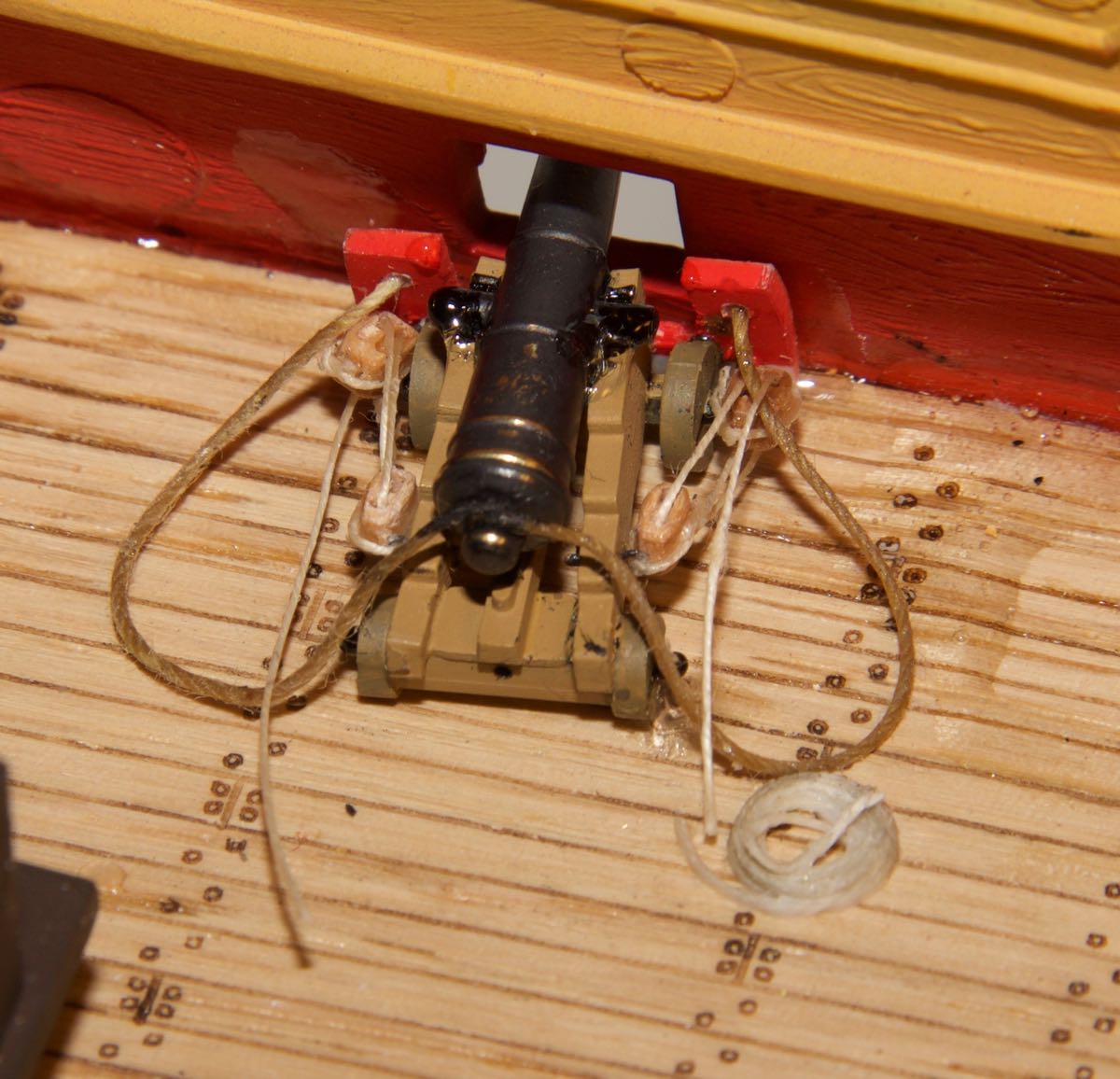 Here is another picture with more of the coiled ropes done – I'm getting better at this!
Here is another picture with more of the coiled ropes done – I'm getting better at this!
 12/4/2016 The third gun deck is finished – all visable cannons have been rigged.
12/4/2016 The third gun deck is finished – all visable cannons have been rigged.
 12/5/2016 Here is a better view of the rope coiling device. I've used black thread here to make everything easier to see. The thread is passed through the white disk and then the parts are assembled. The thread is wound between the white disc and the short brass round part. The spring (from your everyday pen) keeps things compressed.
12/5/2016 Here is a better view of the rope coiling device. I've used black thread here to make everything easier to see. The thread is passed through the white disk and then the parts are assembled. The thread is wound between the white disc and the short brass round part. The spring (from your everyday pen) keeps things compressed.
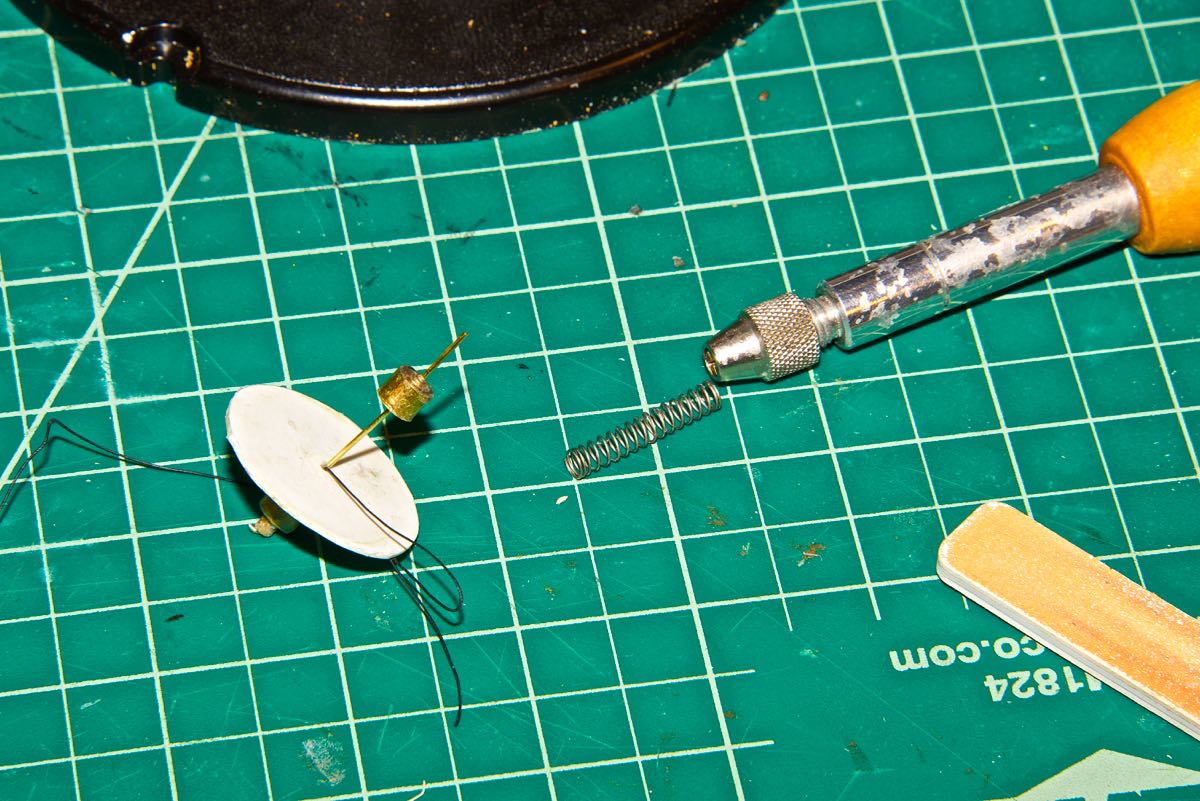 Below are pictures showing the upper deck installed. I had to use some spruce spacers in the bow and stern to keep things spread properly. It was a tight fit, but in the end it all came together.
Below are pictures showing the upper deck installed. I had to use some spruce spacers in the bow and stern to keep things spread properly. It was a tight fit, but in the end it all came together.
 12/8/2016 Here are some general pictures of main deck furnature installation, as well as install of the stern galleries.
12/8/2016 Here are some general pictures of main deck furnature installation, as well as install of the stern galleries.
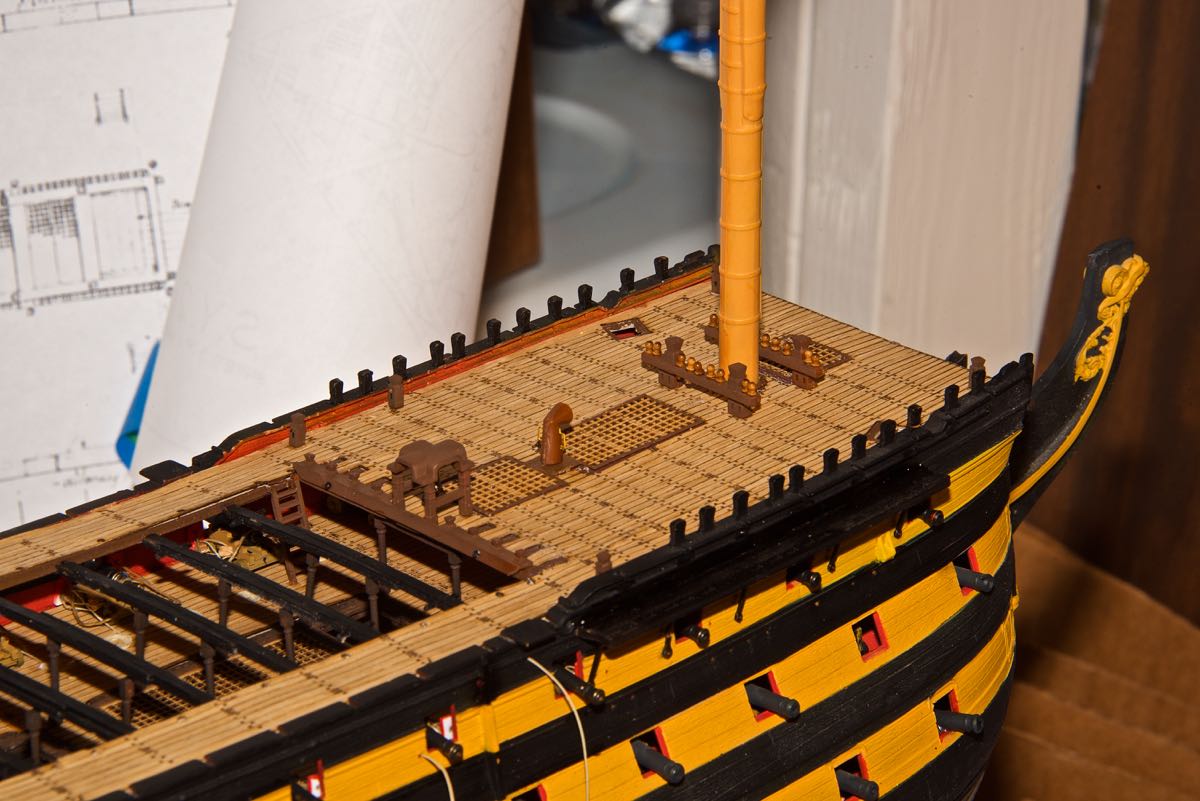
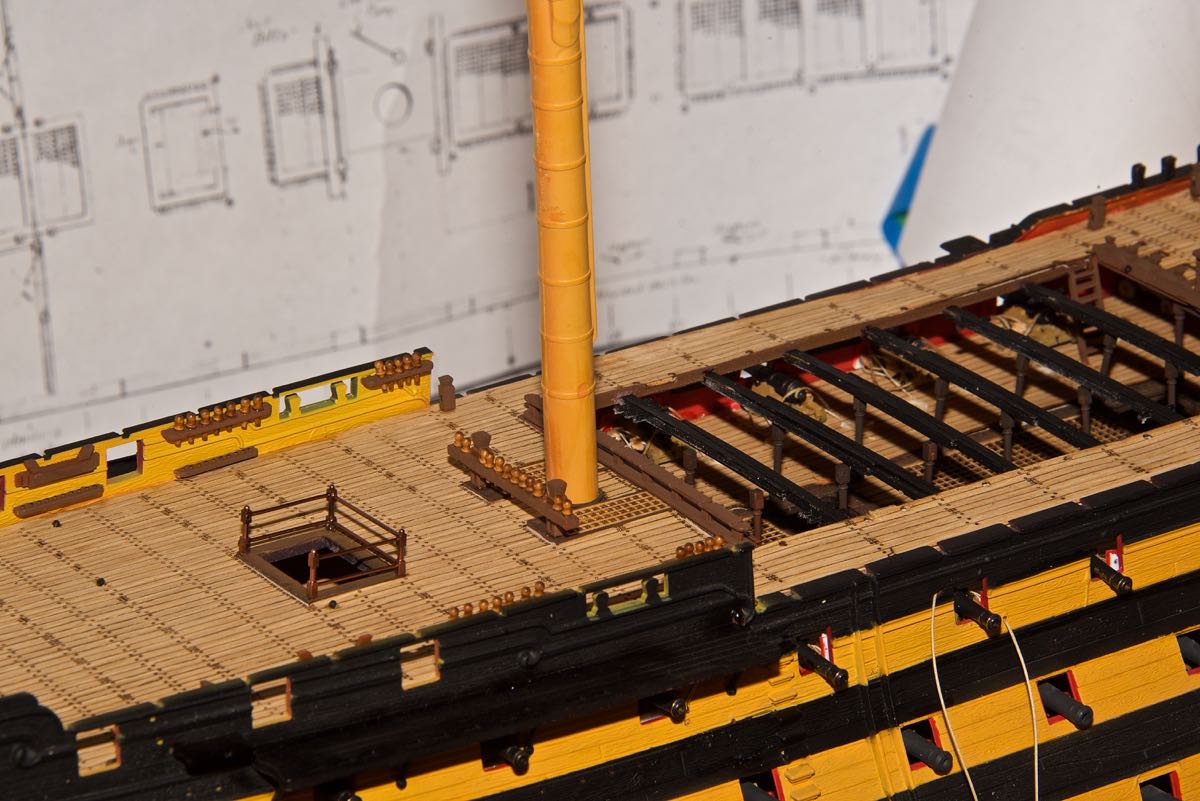
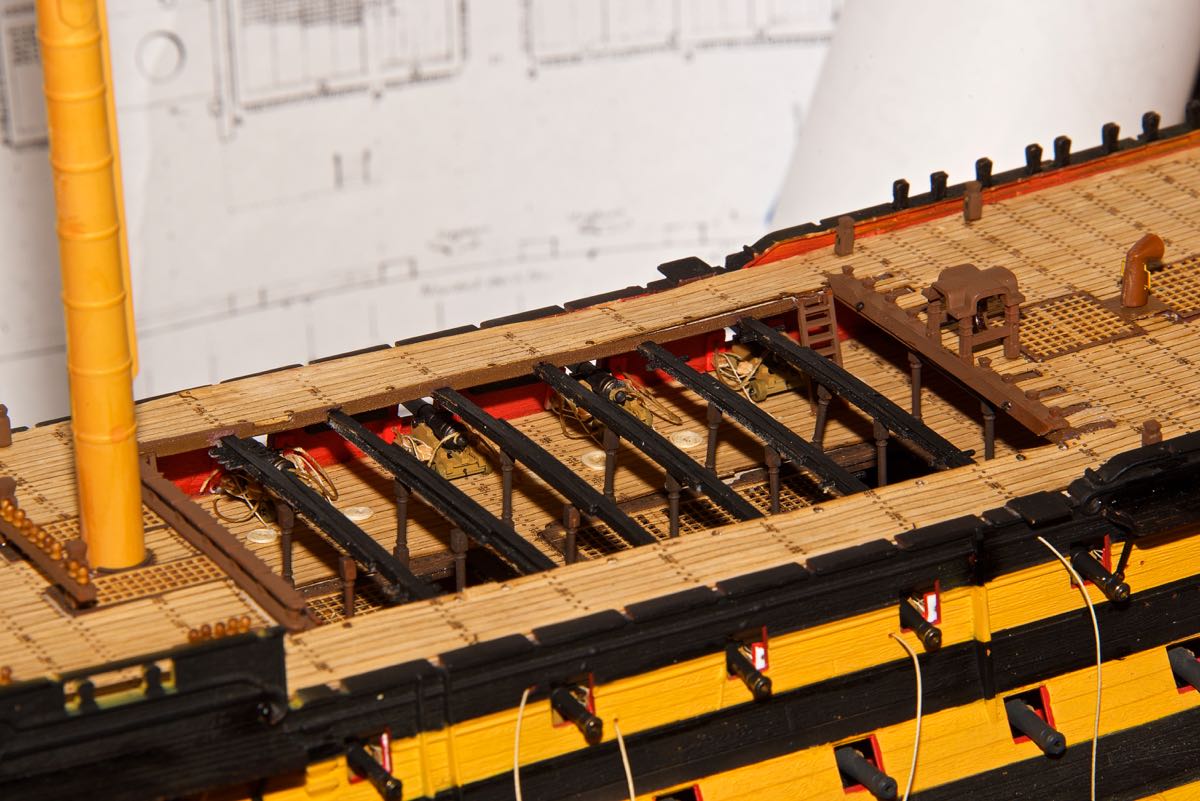

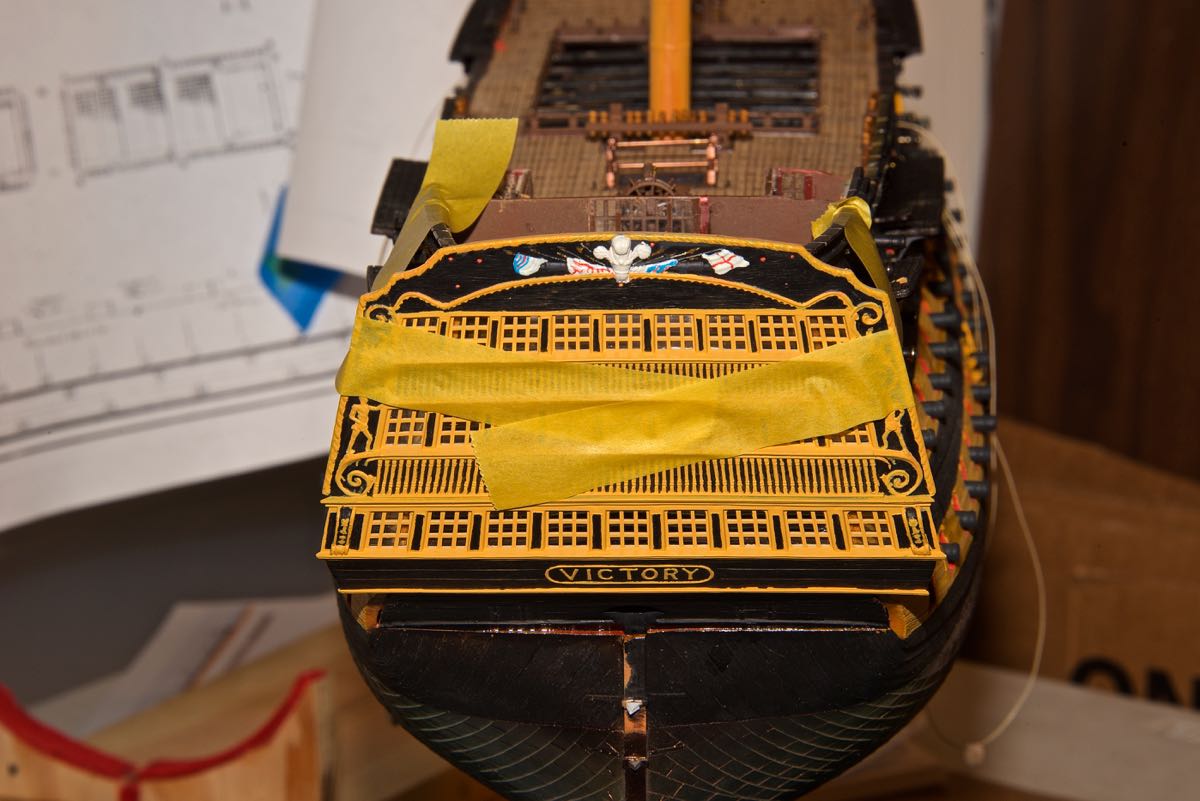

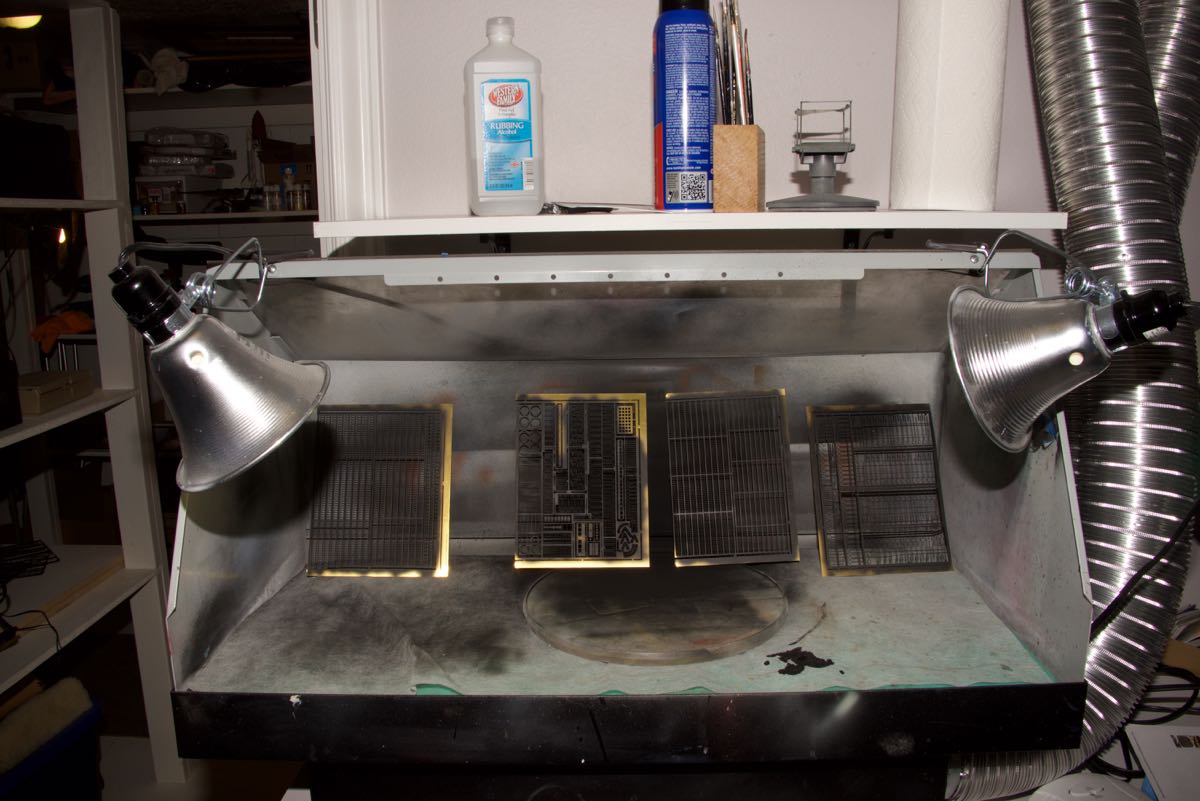
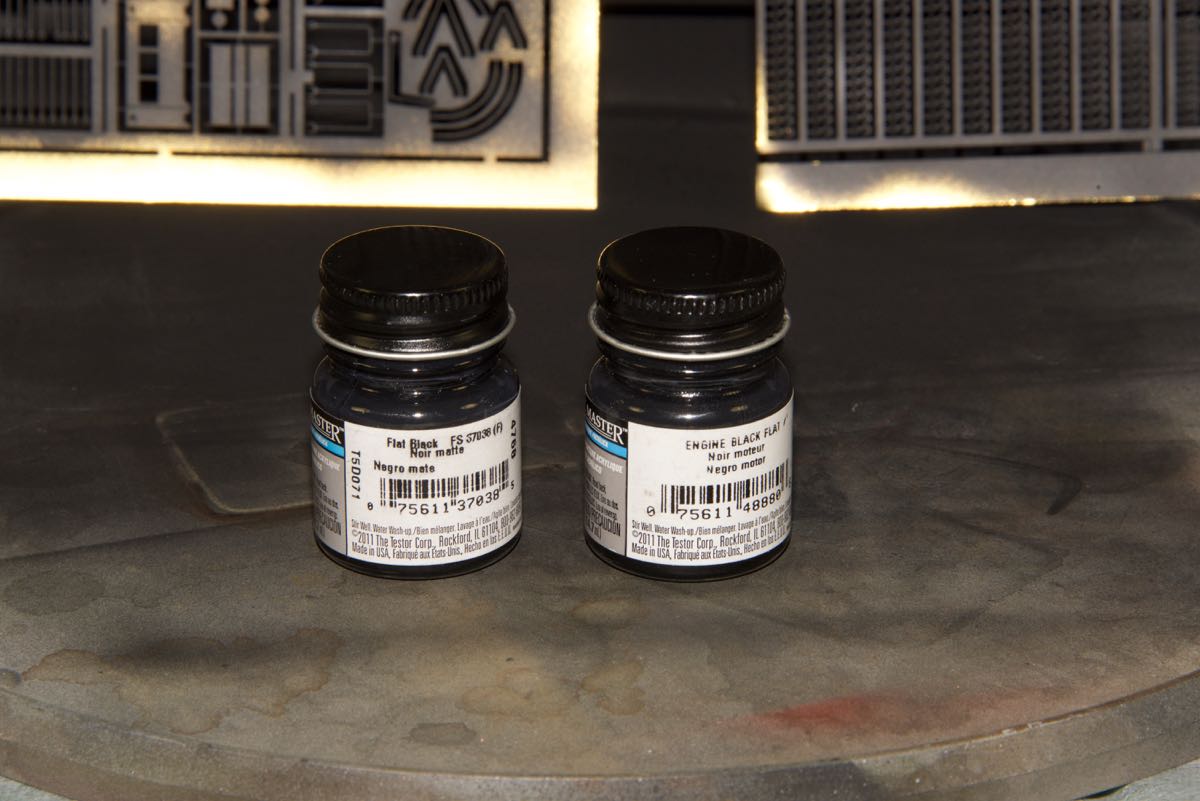

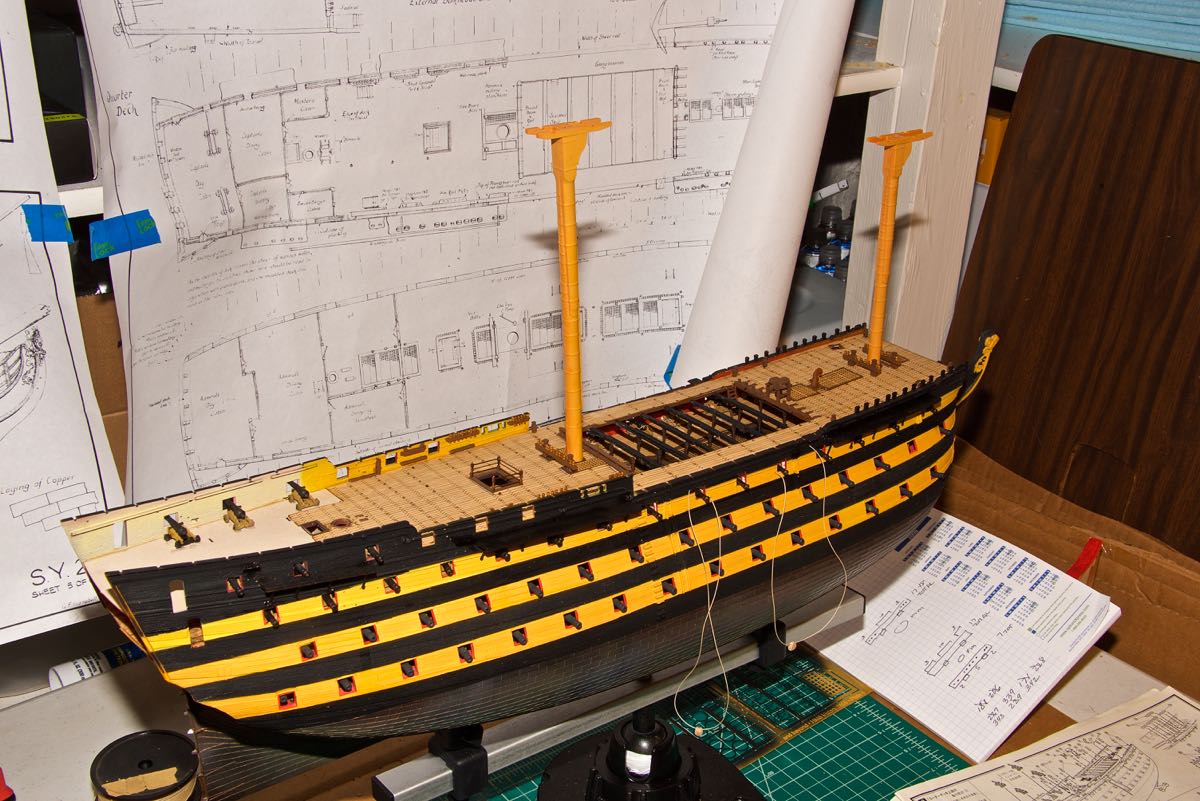
 And here is a photo of the steering as well as the binnacle.
And here is a photo of the steering as well as the binnacle.
 12/9/2016 I've attached the stern galleries. I had to use thin and gap filling super glue as well as thin and thick plastic glue and also epoxy to attach these. It was a process, but it's done.
12/9/2016 I've attached the stern galleries. I had to use thin and gap filling super glue as well as thin and thick plastic glue and also epoxy to attach these. It was a process, but it's done.
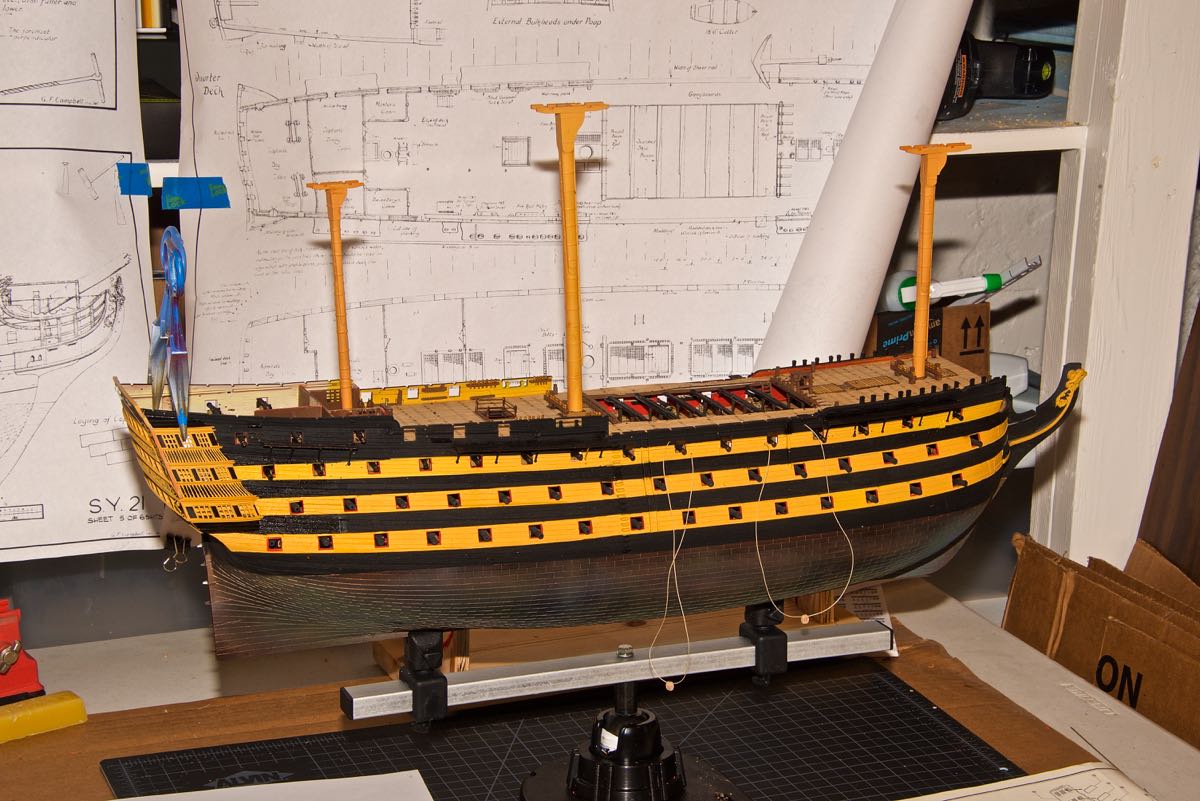

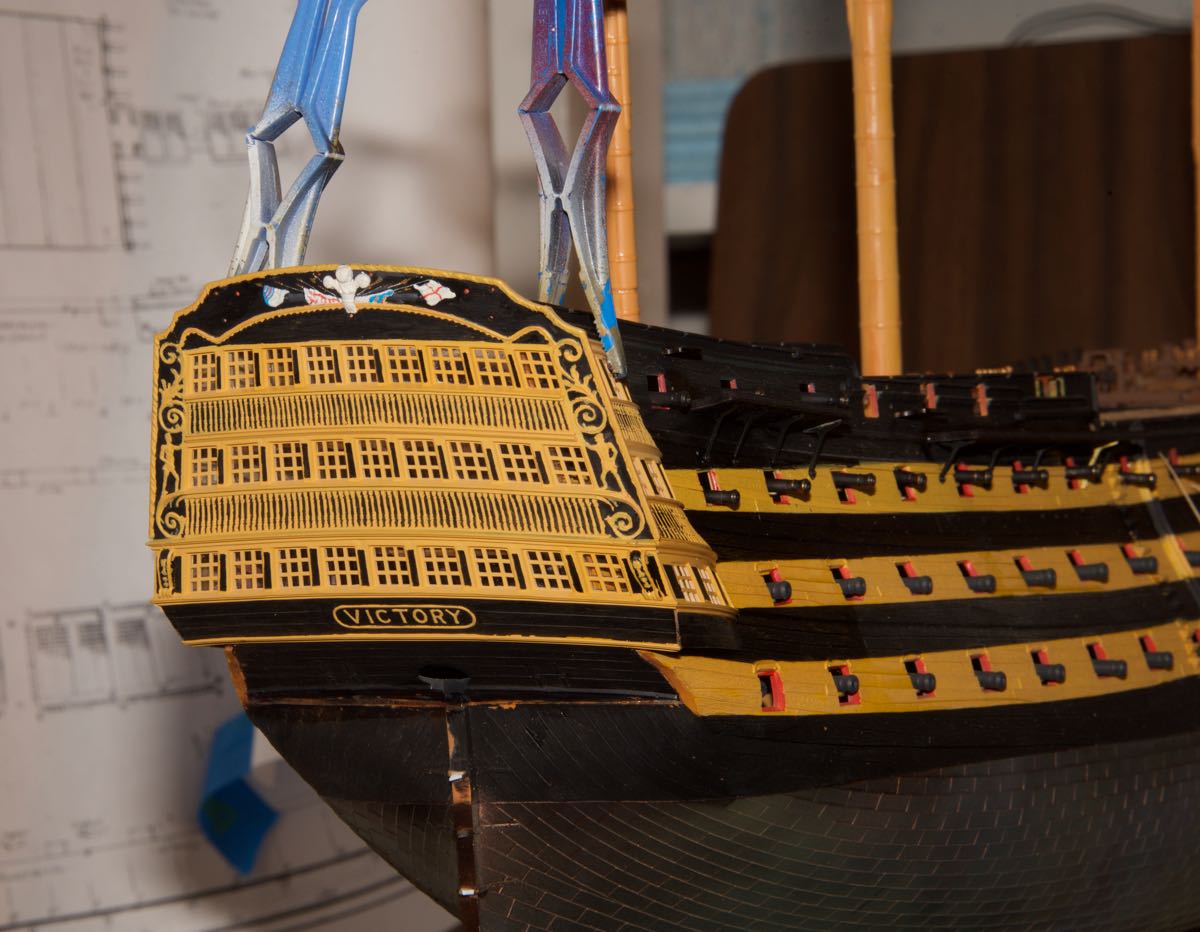 Here is my first pass at one of the visible 12 lb cannons.
Here is my first pass at one of the visible 12 lb cannons.


 12/11/2016 I've installed the first fully rigged cannon.
12/11/2016 I've installed the first fully rigged cannon.
 Now the poop deck is installed.
Now the poop deck is installed.

 12/15/2016 Following are pictures that cover what I've done in the last few days. I've installed some railing with netting and rolled hammocs. I've finished two more cannon and they are sitting on deck awaitiing installation. The rudder has been attached and the rudder irons painted. I used a battery operated soldering iron to melt the netting down to the support ropes – it was much more precise than cutting.
12/15/2016 Following are pictures that cover what I've done in the last few days. I've installed some railing with netting and rolled hammocs. I've finished two more cannon and they are sitting on deck awaitiing installation. The rudder has been attached and the rudder irons painted. I used a battery operated soldering iron to melt the netting down to the support ropes – it was much more precise than cutting.
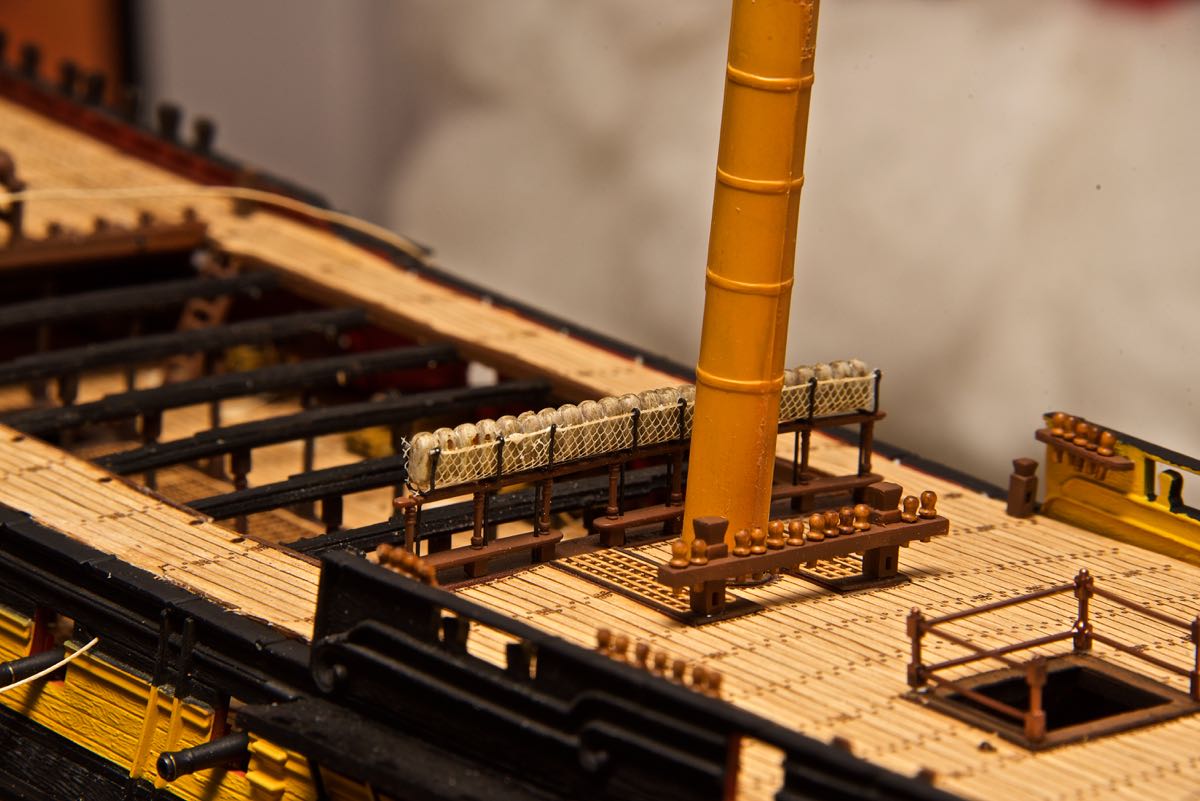
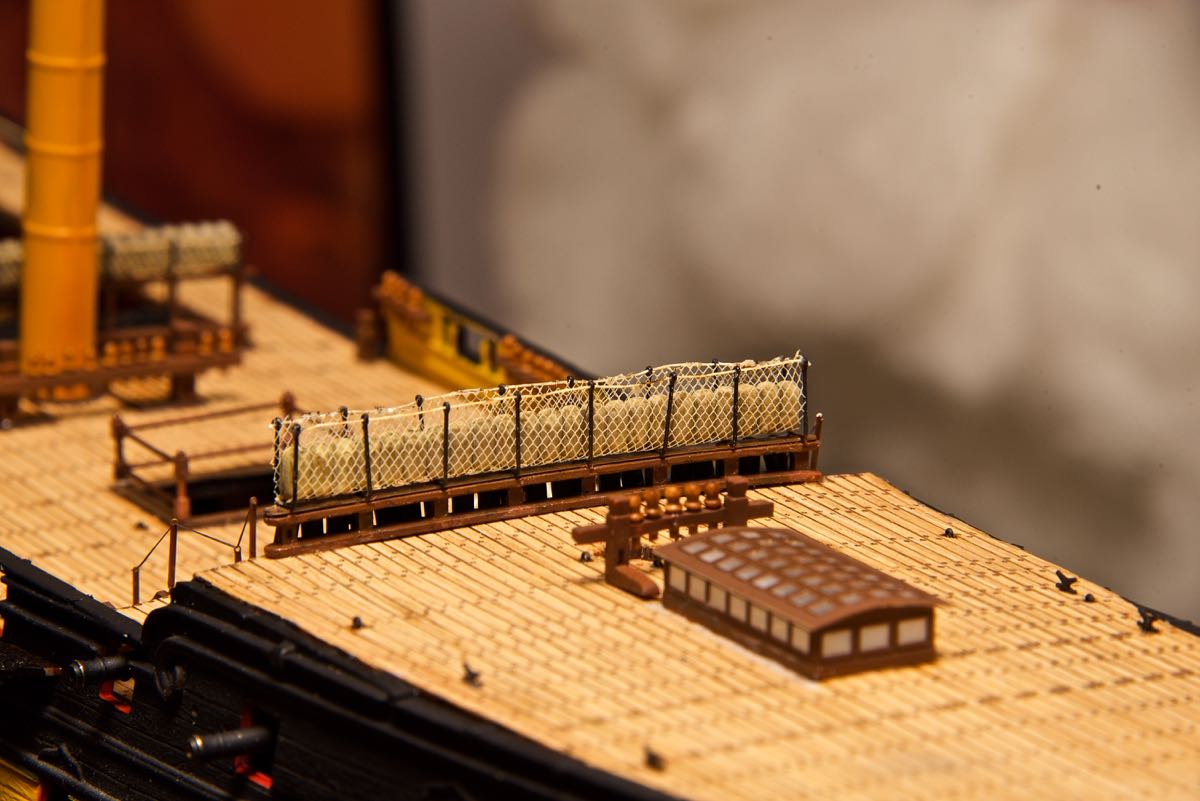
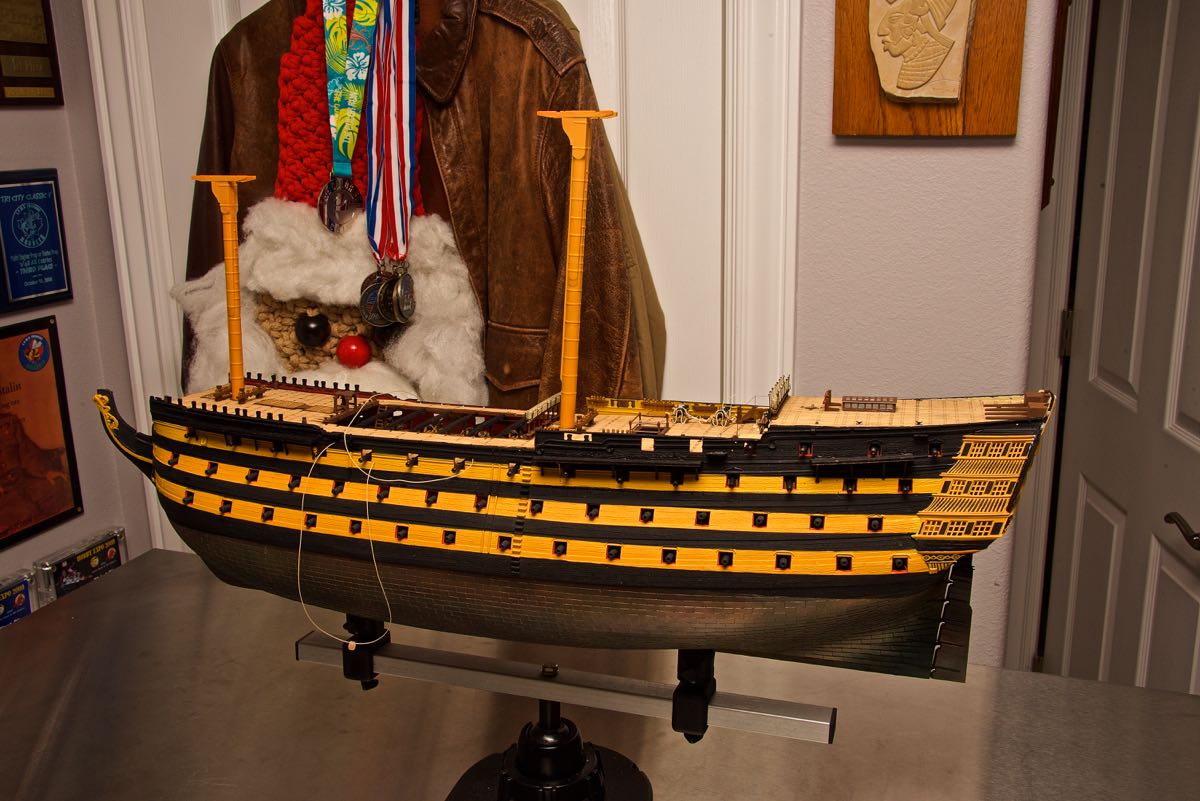

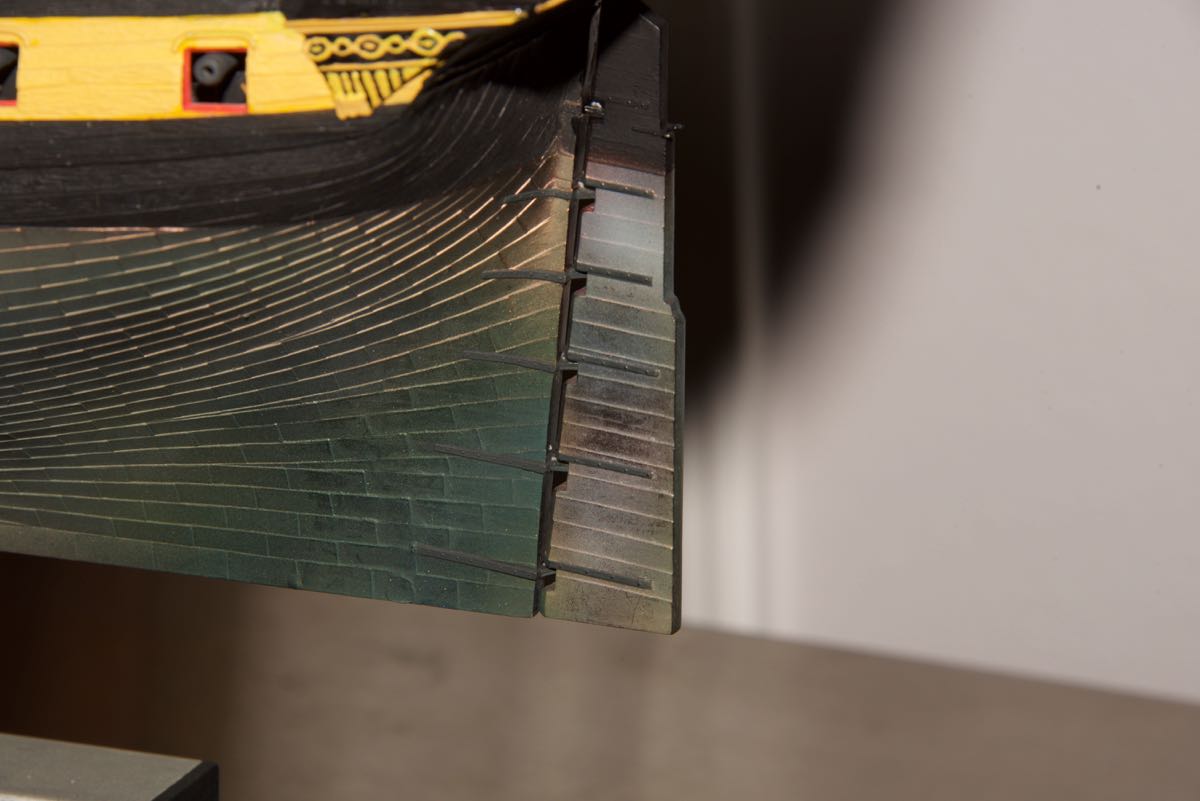

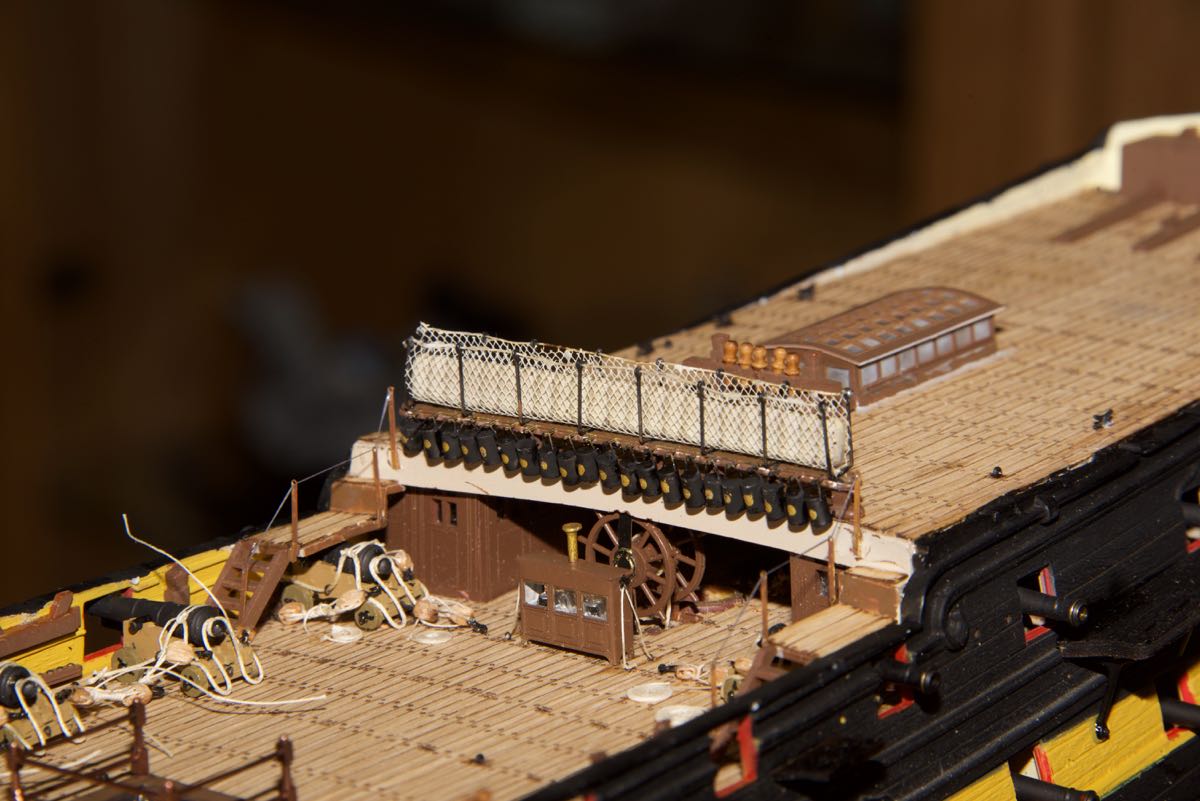
 12/18/2016 I've painted the hammocks with the following – Model Masters aged white flat and Flory's weathering wash (grime) as shown in the following photos:
12/18/2016 I've painted the hammocks with the following – Model Masters aged white flat and Flory's weathering wash (grime) as shown in the following photos:

 12/21/2016 I'v done a lot of work up at the bow. The bow sprit is just set in place here. I've also included a pic of my new serving maching.
12/21/2016 I'v done a lot of work up at the bow. The bow sprit is just set in place here. I've also included a pic of my new serving maching.




 12/22/2016 This is my new ropewalk machine. With it I can produce scale rope from thread.
12/22/2016 This is my new ropewalk machine. With it I can produce scale rope from thread.
 12/23/2016 I've finished the forward cannons.
12/23/2016 I've finished the forward cannons.


 1/2/2017 I've installed the starbord side deadeyes and chains.
1/2/2017 I've installed the starbord side deadeyes and chains.

 1/3/2017 I just had to take a break from all of the deadeyes and chains. So, I worked on the masts – installed the boarding pikes and boom gaff and belaying pin rail, the painted the masts and glued them in.
1/3/2017 I just had to take a break from all of the deadeyes and chains. So, I worked on the masts – installed the boarding pikes and boom gaff and belaying pin rail, the painted the masts and glued them in.
 1/3/2017 10:26 PM I've finally finished the lower deadeyes and chains.
1/3/2017 10:26 PM I've finally finished the lower deadeyes and chains.
 This is a closeup of the foremast deadeyes and chains:
This is a closeup of the foremast deadeyes and chains:
 And – here is a closeup of the mainmast boarding pikes:
And – here is a closeup of the mainmast boarding pikes:
 1/4/2017 Even though the Heller/Imai have you installing the ships boats in the last step – I've decided to install them now. I't a lot easier to do it now – if I wait till the end the rigging will make it really difficult. The downside here is that I'll have to work around the boats as I do the rigging. I hope that goes ok.
1/4/2017 Even though the Heller/Imai have you installing the ships boats in the last step – I've decided to install them now. I't a lot easier to do it now – if I wait till the end the rigging will make it really difficult. The downside here is that I'll have to work around the boats as I do the rigging. I hope that goes ok.

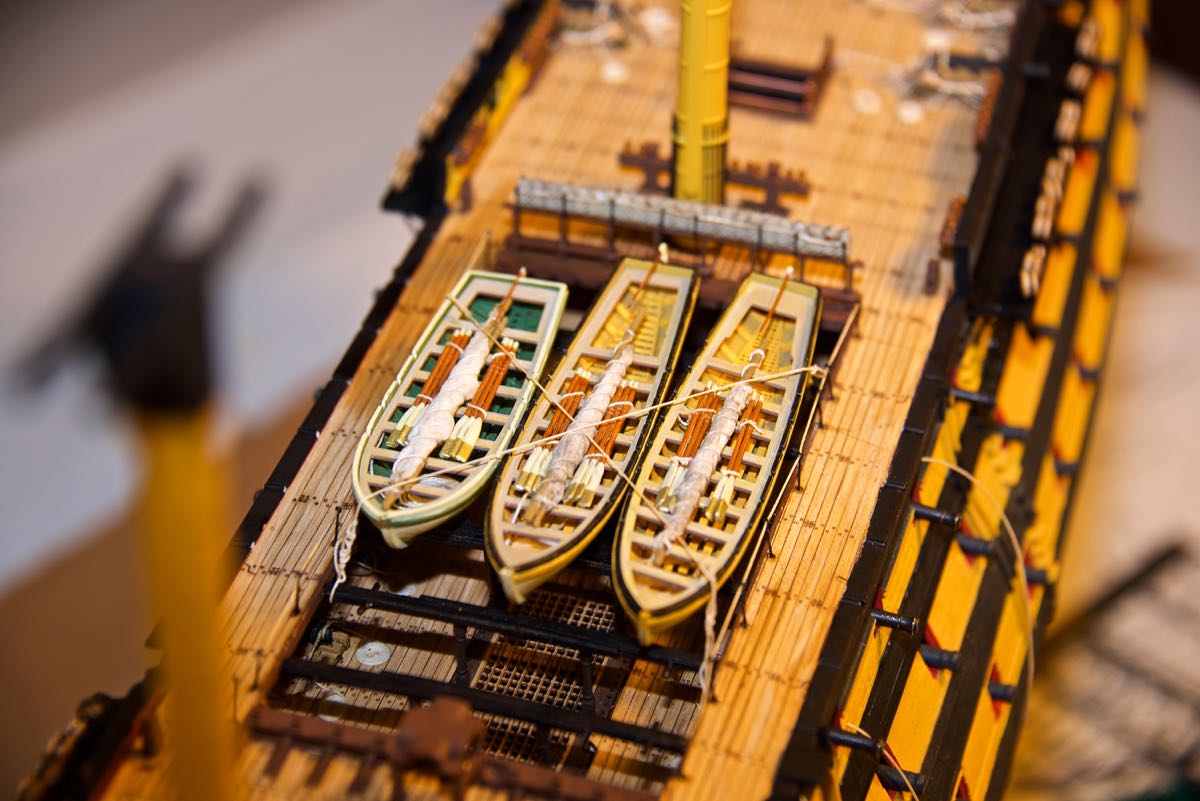 1/5/2017 I'm now working on the brackets, netting for hammocks and hammock placement on the top deck.
1/5/2017 I'm now working on the brackets, netting for hammocks and hammock placement on the top deck.

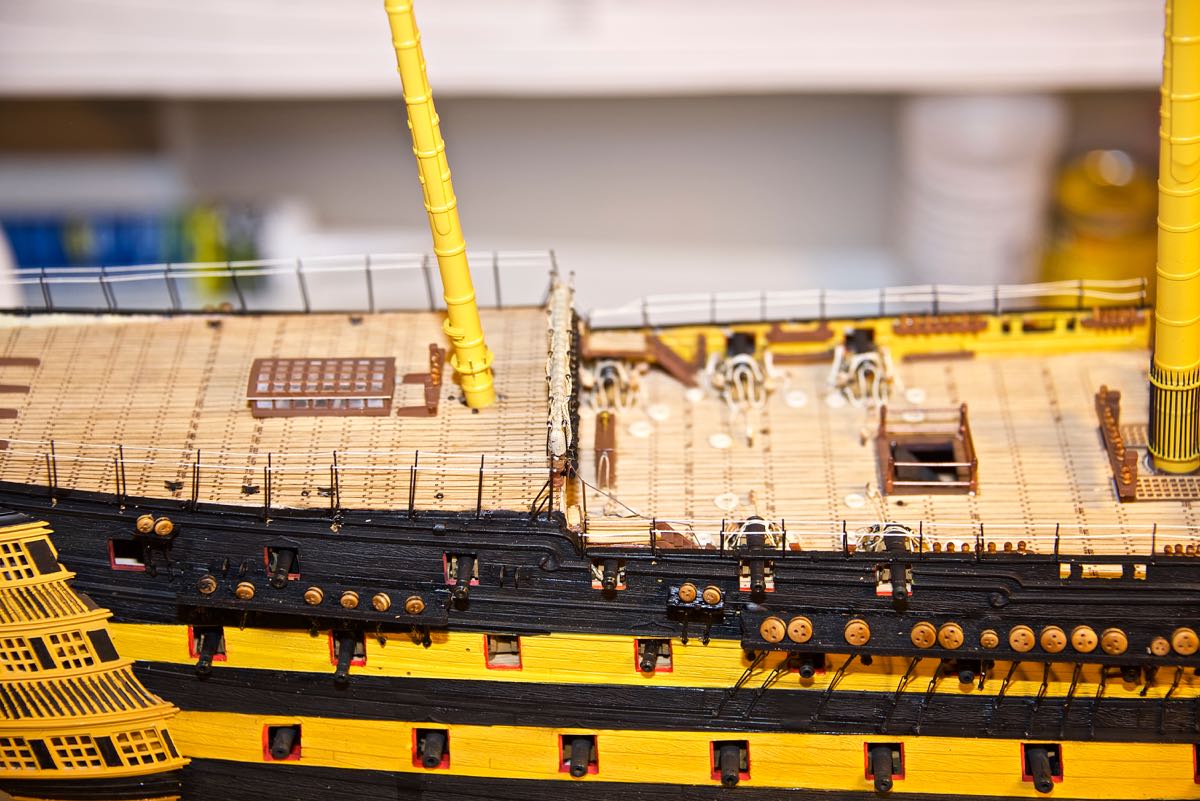
 1/8/2017 I've started the shrouds – working on the mizzen mast first. Rigging the deadeyes proved difficult at first then I got a procedure established that made it very easy. I tied the deadeyes to the shrouds by using my serving machine in manual mode. I've tried 3 different threads for the ratlines – invisible (but still dark) thread, some thread I had purchased, and finally the thread that Imai included with the model. The invisible thread was too stiff, the next thread had too much fuzz, but the Imai thread is perfect. I made up a pattern on paper that I then attached to plastic sheet using contact cement. 30 clove hitches done with about 5000 to go – ha ha.
1/8/2017 I've started the shrouds – working on the mizzen mast first. Rigging the deadeyes proved difficult at first then I got a procedure established that made it very easy. I tied the deadeyes to the shrouds by using my serving machine in manual mode. I've tried 3 different threads for the ratlines – invisible (but still dark) thread, some thread I had purchased, and finally the thread that Imai included with the model. The invisible thread was too stiff, the next thread had too much fuzz, but the Imai thread is perfect. I made up a pattern on paper that I then attached to plastic sheet using contact cement. 30 clove hitches done with about 5000 to go – ha ha.

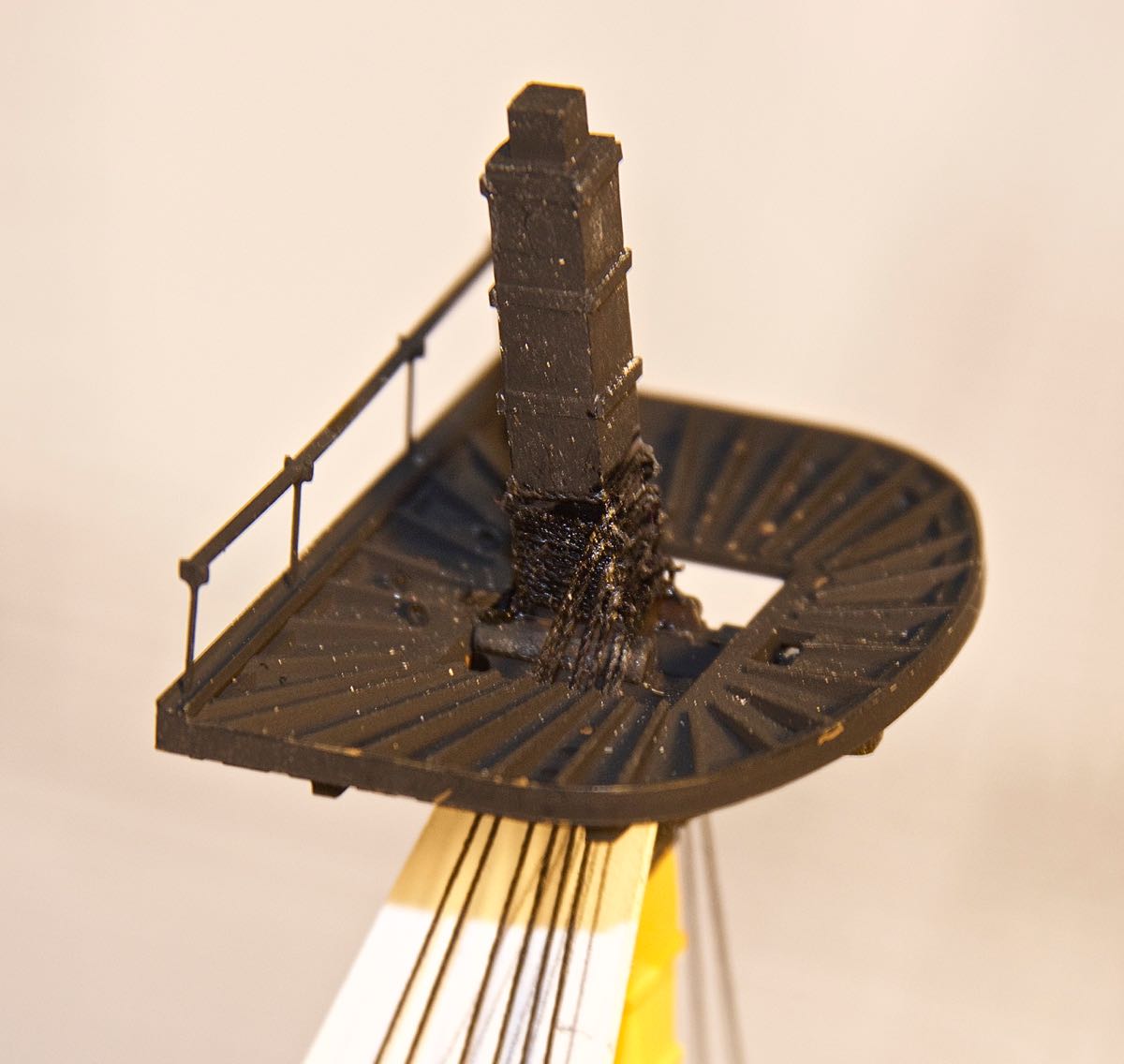
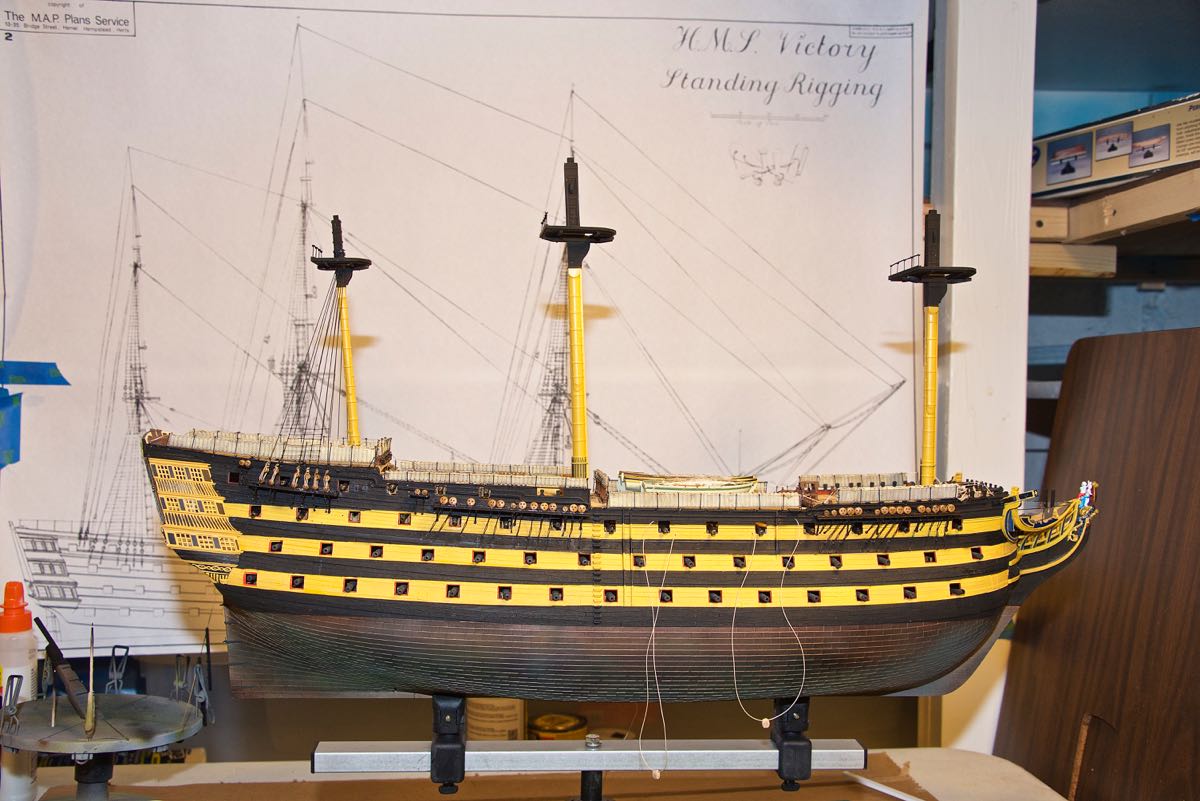
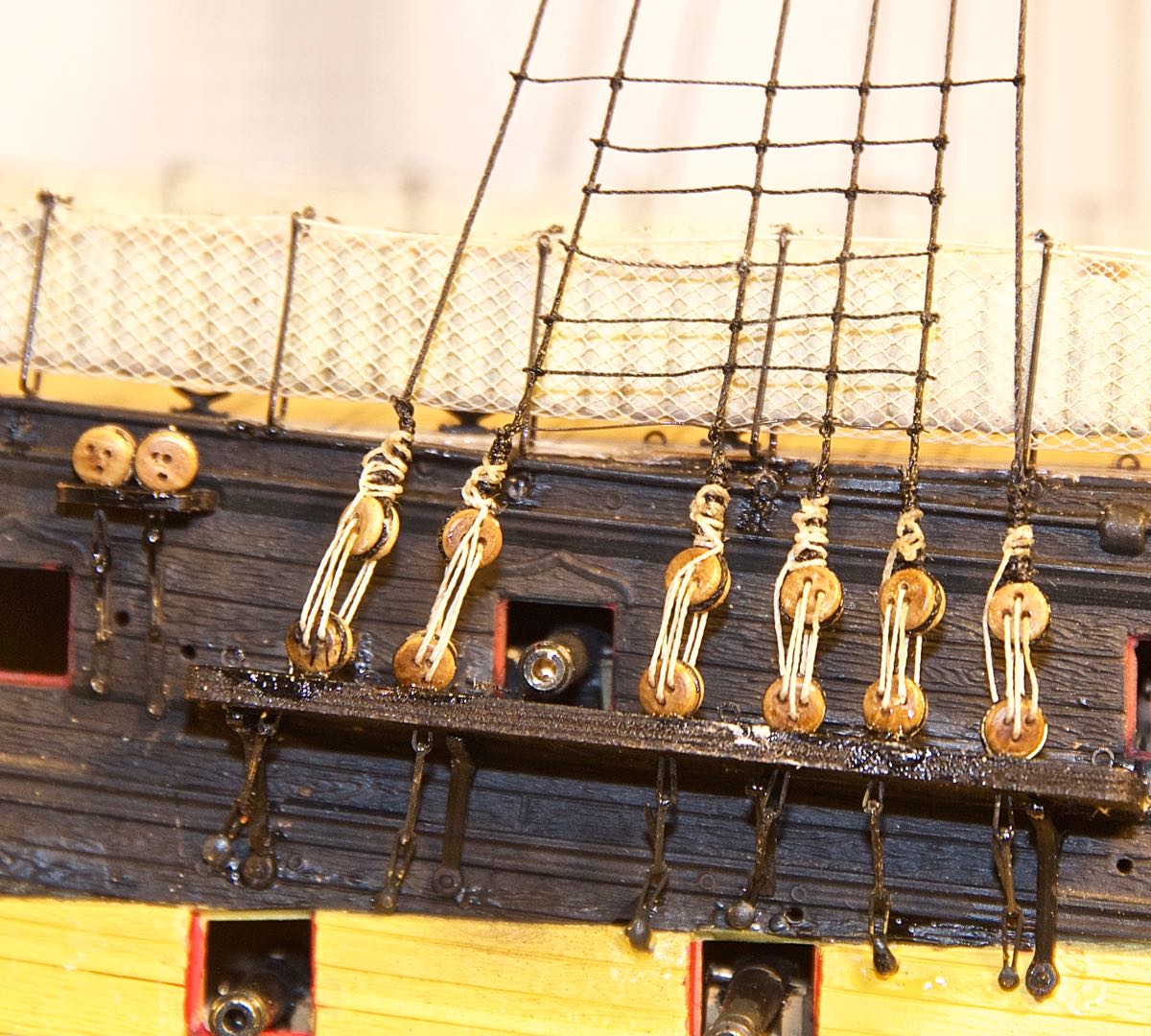 1/10/017 I've added some photos of the latest progress. I've redone the mizzen mast ratlines about 3 times, I continue to have the outside shrouds pulled inward. I've decided to add some temporary outlier shrouds to keep the regular outside shrouds from being pulled inward. You can see this from the picture, I'll have to wait and see if this indeed helps.
1/10/017 I've added some photos of the latest progress. I've redone the mizzen mast ratlines about 3 times, I continue to have the outside shrouds pulled inward. I've decided to add some temporary outlier shrouds to keep the regular outside shrouds from being pulled inward. You can see this from the picture, I'll have to wait and see if this indeed helps.
I've also finished the bow figure's crown and then was able to set the bow spirit and rigg that. I've also added the walkway to the bow spirit. On cannons you can notice the monogram that I've added to the barrel's.




 1/11/2017 I've finished the starboard mizzen ratlines
1/11/2017 I've finished the starboard mizzen ratlines

 1/14/2017 I installed the main shrouds and lower forstays. Both of the lower forstays have been wormed using my serving machine. That worked out really well and looks great. You really can't tell in the pictures tho.
1/14/2017 I installed the main shrouds and lower forstays. Both of the lower forstays have been wormed using my serving machine. That worked out really well and looks great. You really can't tell in the pictures tho.


 1/15/2017 I've made up a ratline jig. I got the idea from an entry on NRG's Model Ship World and slightly modified his idea. It's made up of two lengths of 3mm x 6mm plastistruct with fine sand paper glued on one 3mm side. I use brass wire to close the ends – this traps the shrouds inside and the sandpaper keeps them from sliding around. The 3mm length translates to 12 inches 1/100 scale; this will end up being closer to about 14 inches when all is done which is about right for ratline spacing. As you can see the resulting ratline is nice and straight and hopefully this jug will prevent the dreaded pulling in on the outside shrouds. When I attach the jig to the shrouds I make shure it's level using the level in the last picture. Here are some pics:
1/15/2017 I've made up a ratline jig. I got the idea from an entry on NRG's Model Ship World and slightly modified his idea. It's made up of two lengths of 3mm x 6mm plastistruct with fine sand paper glued on one 3mm side. I use brass wire to close the ends – this traps the shrouds inside and the sandpaper keeps them from sliding around. The 3mm length translates to 12 inches 1/100 scale; this will end up being closer to about 14 inches when all is done which is about right for ratline spacing. As you can see the resulting ratline is nice and straight and hopefully this jug will prevent the dreaded pulling in on the outside shrouds. When I attach the jig to the shrouds I make shure it's level using the level in the last picture. Here are some pics:




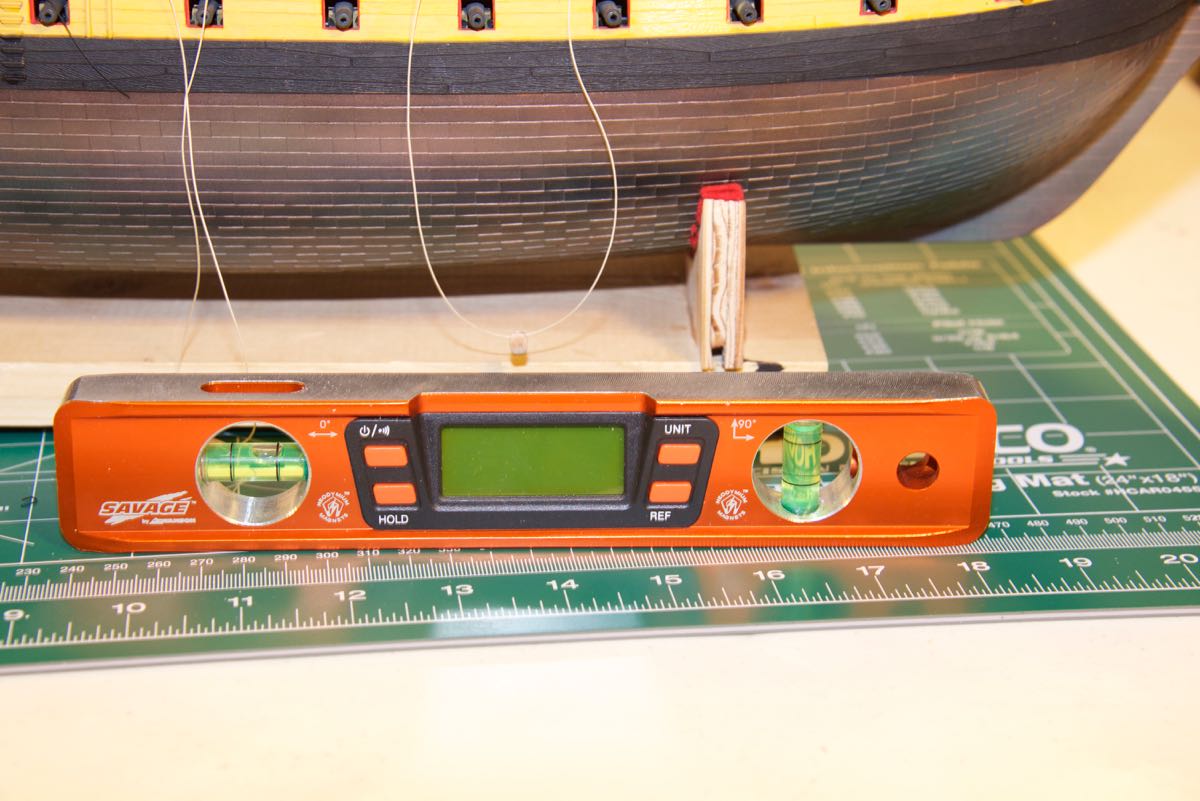 1/17/2017 I've been working on the mainmast ratlines. The starboard side is done, now I'm working on the port side. The ratline jig is really working well.
1/17/2017 I've been working on the mainmast ratlines. The starboard side is done, now I'm working on the port side. The ratline jig is really working well.
 1/19/2017 I've finished the main mast lower ratlines, I've also started to rig the fighting tops. There are several 2 mm blocks on the bottom of each of these, rigging these may be a problem – they aren't in an easy to get to place.
1/19/2017 I've finished the main mast lower ratlines, I've also started to rig the fighting tops. There are several 2 mm blocks on the bottom of each of these, rigging these may be a problem – they aren't in an easy to get to place.

 1/20/2017 I've finished the forward mast lower shrouds. Next I'll be working on the ratlines, and the next section of the bow spirit.
1/20/2017 I've finished the forward mast lower shrouds. Next I'll be working on the ratlines, and the next section of the bow spirit.
 1/21/2017 So for the last month I've had a rash on both arms. I've been to the doctor and he gave me some pretty strong stroids for 5 days. That didn't do it. I got to thinking – maybe I have a reaction to the CA I've been using. I have it out in cups to use so the fumes (I can't smell them) are always there. I'm also using it in a unventelated room – so that isn't good. I've decided to change from CA to clear flat lacquer to seal the rigging knots, and have also ordered a professional mask to wear. Hopefully these things will help.
1/21/2017 So for the last month I've had a rash on both arms. I've been to the doctor and he gave me some pretty strong stroids for 5 days. That didn't do it. I got to thinking – maybe I have a reaction to the CA I've been using. I have it out in cups to use so the fumes (I can't smell them) are always there. I'm also using it in a unventelated room – so that isn't good. I've decided to change from CA to clear flat lacquer to seal the rigging knots, and have also ordered a professional mask to wear. Hopefully these things will help.
I've installed the bow spirit today. The second section is made up of a brass tube with the plastic ends epoxied on. The third and last section is made up of a tapered bamboo shiskabob stick. The kit plastic parts are way too flexible to use. As I've built it the bow spirit is much more rigid and will handle the rigging much better. On to the pics:



 1/23/2017 I've added the lower forestay to the bowspirit and started the lower foremast ratlines.
1/23/2017 I've added the lower forestay to the bowspirit and started the lower foremast ratlines.


 1/27/2017 I've now finished all of the lower shrouds and ratlines, have rigged and installed the fighting tops. I'm finally out of clove hitch hell! At least for a while. I will now start on the upper sections of the masts, working from the mizzen mast forward as I think that will be the easiest.
1/27/2017 I've now finished all of the lower shrouds and ratlines, have rigged and installed the fighting tops. I'm finally out of clove hitch hell! At least for a while. I will now start on the upper sections of the masts, working from the mizzen mast forward as I think that will be the easiest.
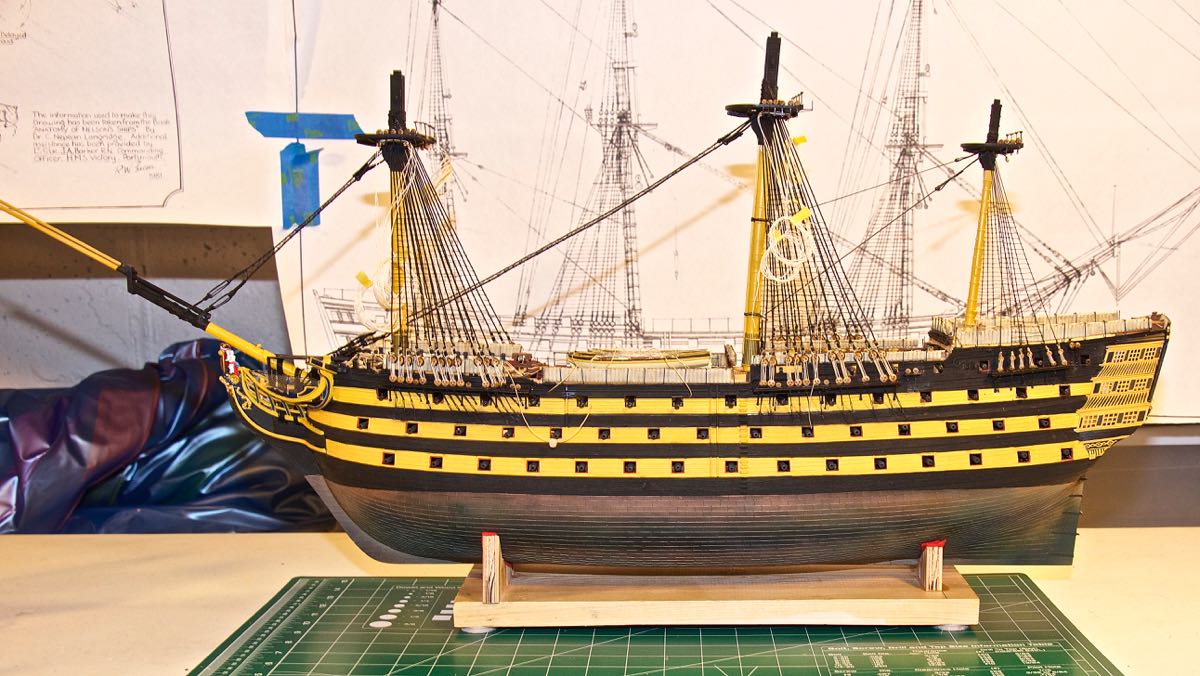
 Here is a pic of my thread rack. I need a lot of thread of different size black and light tan and this helps to keep things organized.
Here is a pic of my thread rack. I need a lot of thread of different size black and light tan and this helps to keep things organized.
 1/28/2017 I've glued together then painted and finally installed the upper mast sections. The main mast and fore mast have brass tubing epoxied inside in the middle sections for rigidity. The alignment between the masts isn't perfect, I'll have to adjust that with the shrouds.
1/28/2017 I've glued together then painted and finally installed the upper mast sections. The main mast and fore mast have brass tubing epoxied inside in the middle sections for rigidity. The alignment between the masts isn't perfect, I'll have to adjust that with the shrouds.

For more on this model build go to page 2 HERE.
